 | |
|  |
Found 29 matching news posts: |
view titles only (low bandwidth) |
| |
| Fare thee well, thou shooting star | Sep 19, 2017 9:27 PM PDT | url |
| | |
Added 1 new A* page:On Friday, the Cassini probe took its planned swan dive into the planet Saturn, ending its 20-year mission to the ringed planet. I've mentioned Cassini in 28 previous A* blog posts, so it's safe to say the probe's adventures, readings and discoveries have had a profound impact on this webcomic! I can't possibly list all of Cassini's scientific achievements in this one blog entry but, among other things, it discovered seven new moons of Saturn, dropped the Huygens lander on the moon Titan, getting us ground photos from Titan's surface, and it discovered water ice jets shooting out of the moon Enceladus, revealing a vast subsurface ocean.
You can see images Cassini took in its final, exploratory plunges over here, including an infrared view of what would become its own impact site in the colossal banks of clouds. My own favorite photos from Cassini have always been its views of Enceladus; here's a fittingly solitary, distant one it took of Enceladus and the famous ice jets in April of this year:
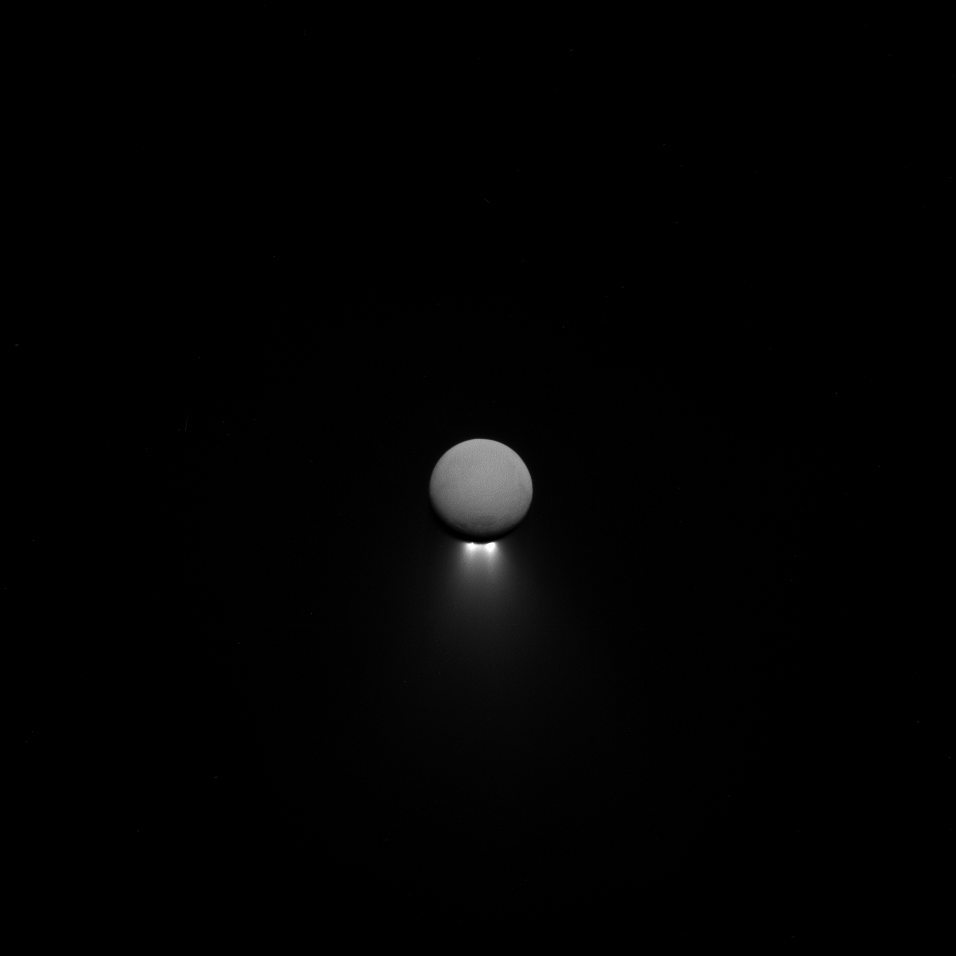
image by NASA/JPL-Caltech/Space Science Institute (source)
|
·····
|
| |
| Potential microorganism food in Enceladus | Apr 18, 2017 10:15 PM PDT | url |
| | |
Added 1 new A* page:There was a lot of news last week about potential habitable (or previously habitable) water worlds in our solar system; I *think* this was spurred by NASA finally concluding that the Cassini probe did detect molecular hydrogen in a plume of ice it flew through from Saturn's moon Enceladus in late 2015—that's what the BBC's article is about, anyway.
On Earth, hydrogen molecules can get into seawater like so: "At the mid-ocean ridges on our planet, seawater is drawn through, and reacts with, hot upwelling rocks that are rich in iron and magnesium. As the minerals in these rocks incorporate H2O molecules into their crystal structure, they release hydrogen..." So, detecting hydrogen in the geysers thought to be spewing upward from Enceladus' subsurface oceans *could* mean that those oceans have hot underwater vent areas that could support life; at any rate, the food source those vent areas have is definitely present in Enceladus: on Earth, microorganisms classed as "methanogens" use released hydrogen as food—they "make methane as they react the hydrogen with carbon dioxide."
The article mentions that to detect the presence of actual tiny life forms, or their unmistakable traces, in the ice plumes shooting out of Enceladus, you would need a different kind of spectrometer than Cassini is equipped with, and that "a proposal is being put together to fly them in 2026."
It ends with an informative biochemistry quote from Cassini scientist Dr. Hunter Waite: "For life, you need liquid water, organics, and the CHNOPS elements (carbon, hydrogen, nitrogen, oxygen, phosphorus, sulphur). OK, we haven't yet measured phosphorus and sulphur at Enceladus. But you also need some kind of metabolic energy source, and the new Cassini results are an important contribution in that regard."
|
·····
|
| |
| Cassini: closest-ever view of Atlas | Apr 17, 2017 9:08 PM PDT | url |
| | |
Added 1 new A* page:Last month I posted about some close-up new photos the Cassini probe had taken of Saturn's tiny moon Pan, and now we've got even closer-up (within 7,000 miles, whereas it only got within 15,000 of Pan) photos of another small Saturnian moon, Atlas (some confusion as to its size, though: Wikipedia says Pan is 35 km across; it says Atlas is 40 km across, but NASA's article with the photos says Atlas is just "19 miles, or 30 kilometers across"). Like Pan, Atlas has a relatively huge equatorial ridge, probably consisting of material falling onto it from Saturn's rings; Atlas' ridge is smoother than Pan's, though, leaving it more blobby than saucer-like:
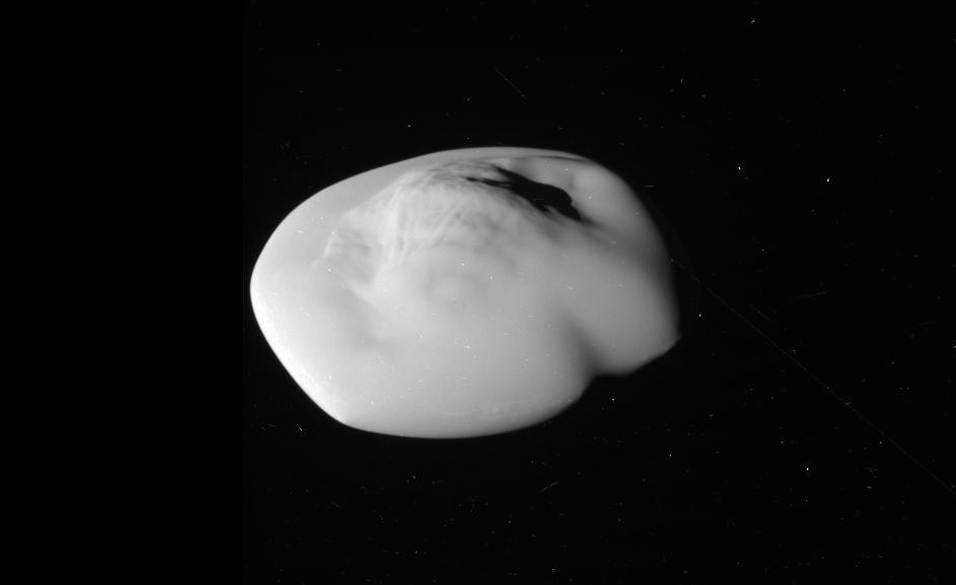
photo by NASA/JPL-Caltech/Space Science Institute
Them crazy moons! : o
|
·····
|
| |
| Cassini's last visit to Mimas | Mar 17, 2017 12:21 AM PDT | url |
| | |
Added 1 new A* page:Just as NASA's Cassini probe, in its final tour of the Saturnian system, last week returned some great up-close photos of the tiny moon Pan, now it has got some from about the same distance (25,000 km) of the larger moon Mimas:
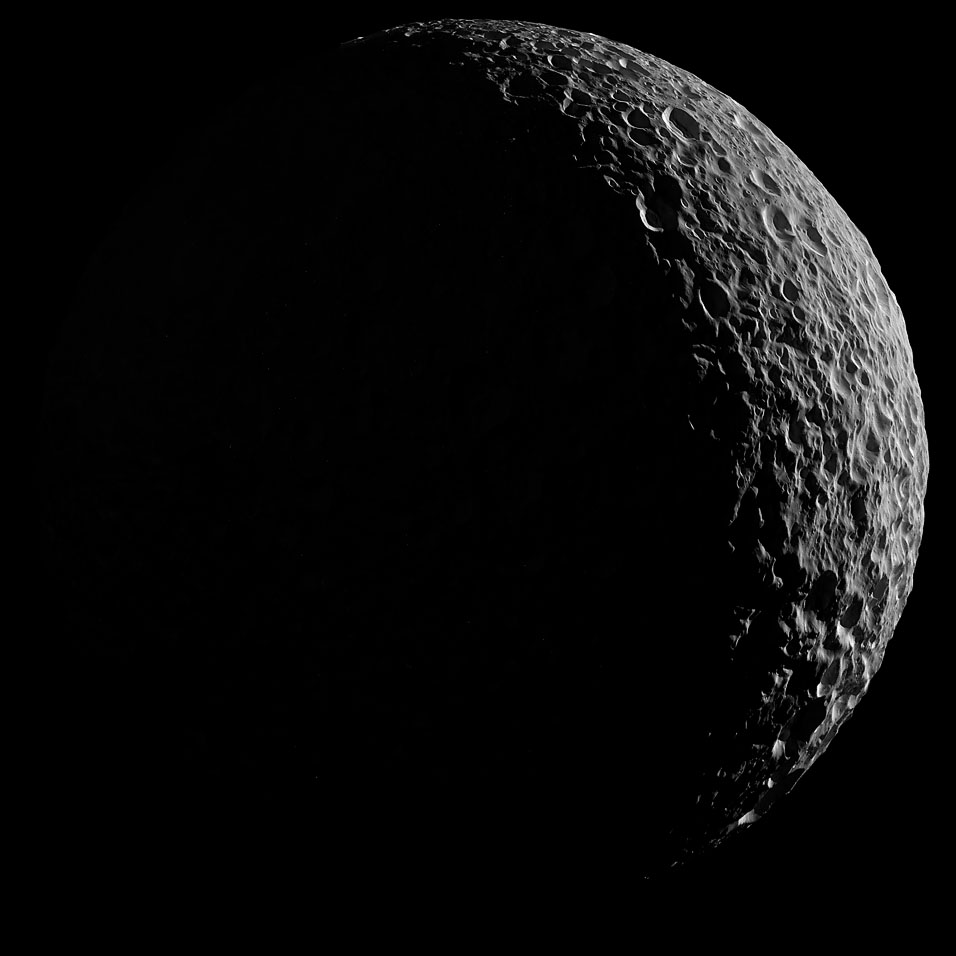
image by NASA/JPL-Caltech/Space Science Institute (source)
If you crank up the brightness and contrast, you can even see the side of the moon that is dark in the above image, since it is actually very faintly illuminated by light reflected from Saturn itself:
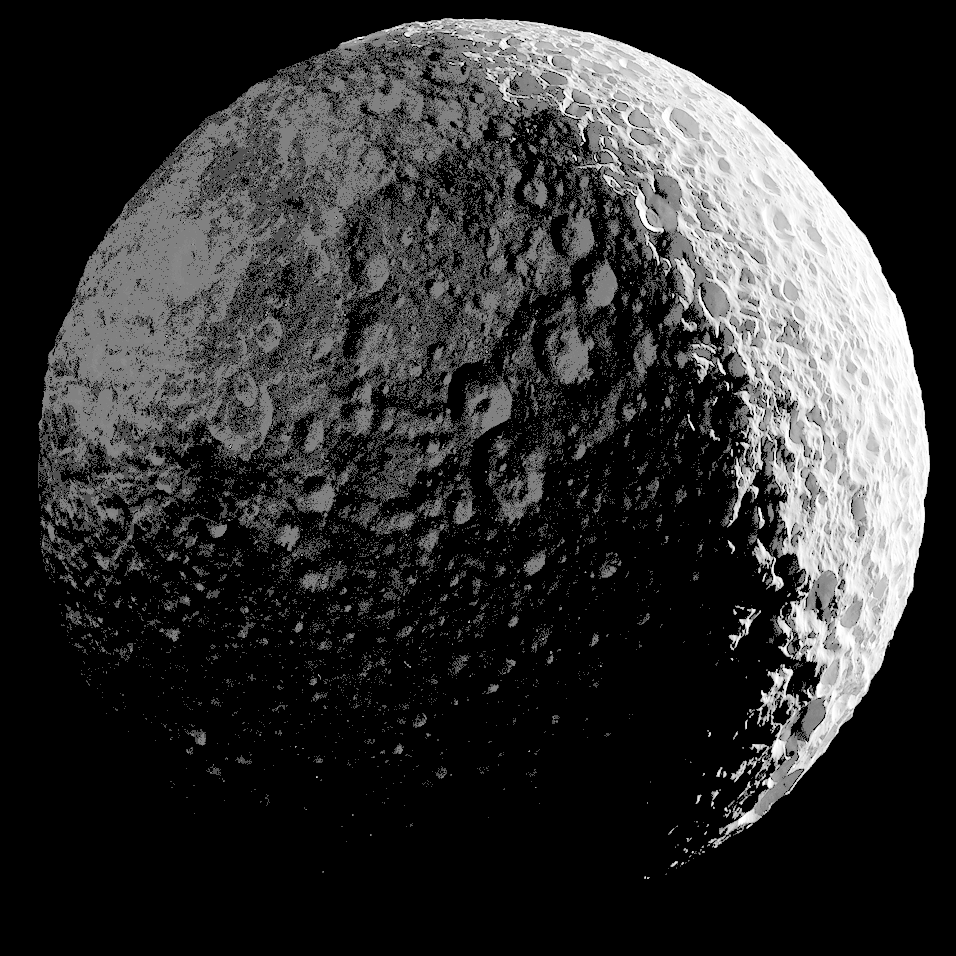
NASA has a less grainy but also less seamless mosiac image doing that on the same NASA source page.
This is not the closest Cassini has come to Mimas; in 2010, it passed within 9,500 km in 2010, and got a clearer if less dramatically lit image of the Moon, including its large crater Herschel, which is about the right size to make Mimas look kind of like the Death Star from Star Wars (although in this case, it is a moon : p):
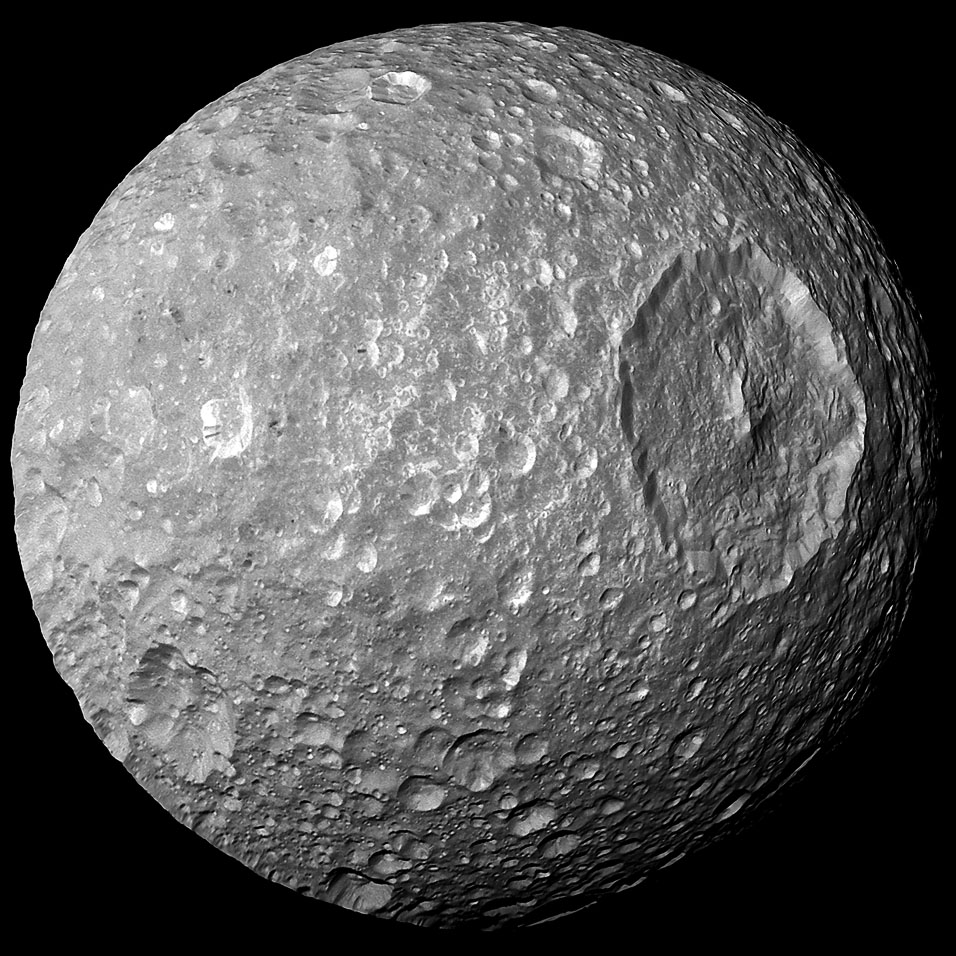
image by NASA/JPL-Caltech/Space Science Institute (source)
Mimas is about 400 km across, but if you look closely at those photos, it might start to look a little funny to you; you see, it isn't quite round! It's "about 10%" taller than it is wide—prolate—due to the tidal force Saturn exerts upon it, scrunching it up a bit.
|
·····
|
| |
| Cassini sees tiny Pan's giant ridge | Mar 13, 2017 9:48 PM PDT | url |
| | |
Added 1 new A* page:NASA's Cassini probe is getting some great stuff in its last sweeps through the Saturnian system; it just passed within 25,000 km of the tiny, 35-km-wide inner moon Pan and found the moon's shape dominated by a massive equatorial ridge:
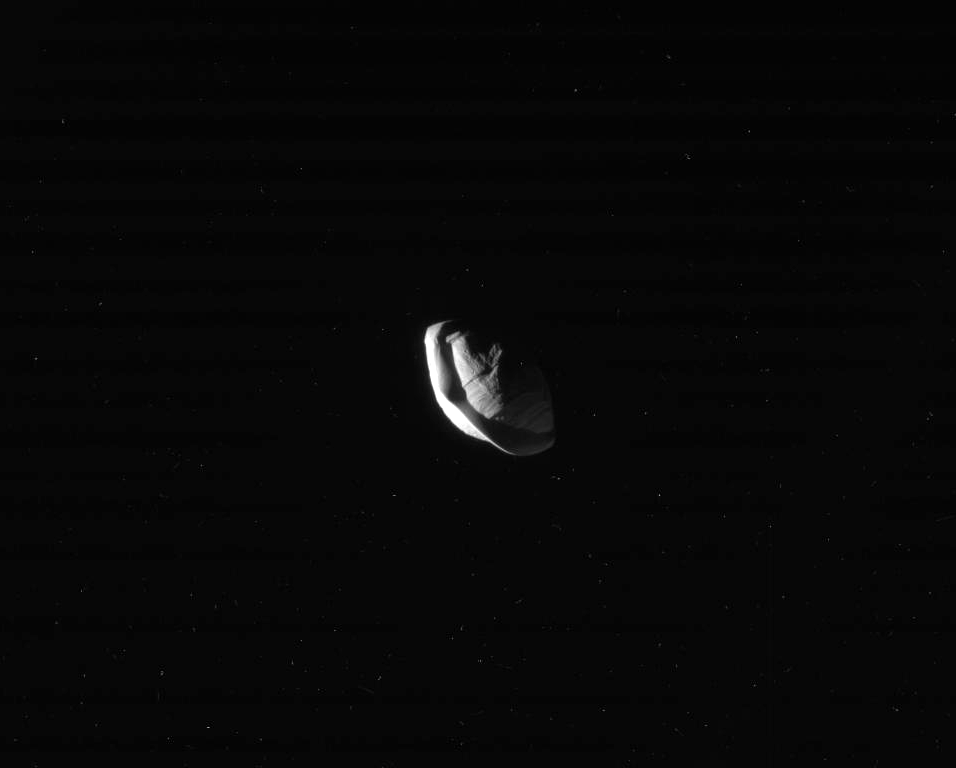
image by ASA/JPL-Caltech/Space Science Institute (source)
^ More photos of the strangely shaped moon on the Jet Propulsion Laboratory's site at that "source" link. : ) The equatorial ridge forms when material from Saturn's nearby rings falls onto the moon as it sweeps past them. Such ridges are not unusual among Saturn's moons: Atlas and the much larger Iapetus have them, for instance.
Thanks to my brother for tipping me off to the new Pan photos. : )
|
·····
|
| |
| Cassini out with a bang next year | Dec 06, 2016 11:24 PM PST | url |
| | |
Added 1 new A* page:NASA's highly successful Cassini probe, which has been studying Saturn's rings and moons for the past twelve years, is running low on fuel, and will be sent on a death plunge into Saturn on September 15th, 2017, according to the BBC. Dang! But leading up to that, it will do some pretty cool stuff. Currently it is engaged in a series of 20 orbits that take it over Saturn's north pole, then out to the outer boundary of its main ring system, just past the F ring; during these trips, it will have the chance to sample F ring particles. Then, beginning on April 22nd, it will conduct a series of dives "between the inner edge of the rings and the planet’s atmosphere," so close that "it could pass less than 2,000km above Saturn’s cloud tops." This should "permit close-up investigation of Saturn’s interior"; for instance, there is some hope that it will help us learn the length of a day on the cloud-shrouded giant, whose current day length is only known as vaguely as "10.7 hours plus or minus 0.2 hours."
So that should be pretty spectacular, but I'll still be a little sad to see Cassini go—even just on a visual level, its photos of Saturn and its moons—ice geysers on Enceladus!!—have been spellbinding, and its discoveries—methane seas on Titan!—really have opened up whole new worlds to us. If you want to see some of those amazing photos, and learn more about what Cassini has been up to around Saturn, head on over to NASA JPL's lavishly illustrated Cassini: Mission to Saturn web site.
|
·····
|
| |
| See methane clouds moving on Titan | Nov 07, 2016 10:31 PM PST | url |
| | | |
Added 1 new A* page:NASA recently posted a time-lapse video, shot by the Cassini space probe, of methane clouds circling "the far northern regions of Saturn's largest moon, Titan." They even set it to kind of eerie music. : o
|
·····
|
| |
| ESA's Mars crash & other space news! | Nov 02, 2016 9:40 PM PDT | url |
| | |
Added 1 new A* page:Finally got some blogging time! Let's do a BBC space news roundup! : D
- China's Shenzhou 11 docks at Tiangong 2 space station (10/19) - Two Chinese astronauts are spending 30 days at the country's somewhat scaled-down space station, which is a test bed for a full-sized station planned for 2020 or 2022, depending on which number in the article you go by. Their 30-day mission will be the longest space mission ever undertaken by Chinese astronauts; in the article, you can see their footage of the station interior and exterior.
- Saturn's weird hexagon changes colour (10/25) - The huge, hexagonal cloud area at Saturn's north pole has changed from a blue to a gold color over the past four years, a comparison of old and new photos of the area taken by NASA's Cassini probe reveals. "The change in colour is thought to be the result of seasonal changes on the planet. In particular, the amount of sunlight falling on the poles affects the production of suspended particles - aerosols - in the atmosphere. Scientists think the shift from a bluish colour to a golden one may be due to more aerosols being produced through reactions involving sunlight and the atmosphere." The hexagonal shape of the cloud formation has also been a mystery, but the article notes that computer simulations have been able to show that "small perturbations in winds flowing around the north pole can form a hexagon shape rotating at speeds close to those of the real one."
- Images reveal crashed Mars lander (10/27) - The ESA lost contact with their Mars lander Schiaparelli in the minute before it was due to touch down on The Red Planet; ESA mission control tried to remain optimistic about the probe's chances, but NASA's MRO satellite spotted what pretty much looked like a crash site near where the probe was supposed to land, and then confirmed it with high resolution photos of the site some days later. (The MRO is an old hand at this now; last year, it located the 12-year-old wreckage of the ESA's previous attempted Mars lander, Beagle 2—which did land, but its solar panels and communications instruments failed to deploy.) It isn't known exactly what went wrong for Schiaparelli, but for some reason its parachute deployed early, and its retro-rockets fired for only 3 or 4 seconds instead of the intended 30; this probably resulted in the probe falling from 2 to 4 kilometers up, hitting the surface at something like 300 kph (186 mph). The ESA can console themselves a little by having successfully placed Schiaparelli's mothership, the Trace Gas Orbiter, in Martian orbit, where it will for the presence of methane in the atmosphere, which would be a possible indicator of biological or geological activity on the planet.
|
·····
|
| |
| Enceladus wobble reveals global ocean | Sep 16, 2015 11:07 PM PDT | url |
| | |
Added 1 new A* page:According to a new BBC article, seven years of studying the Cassini probe's photos of Saturn's moon Enceladus—like these, maybe
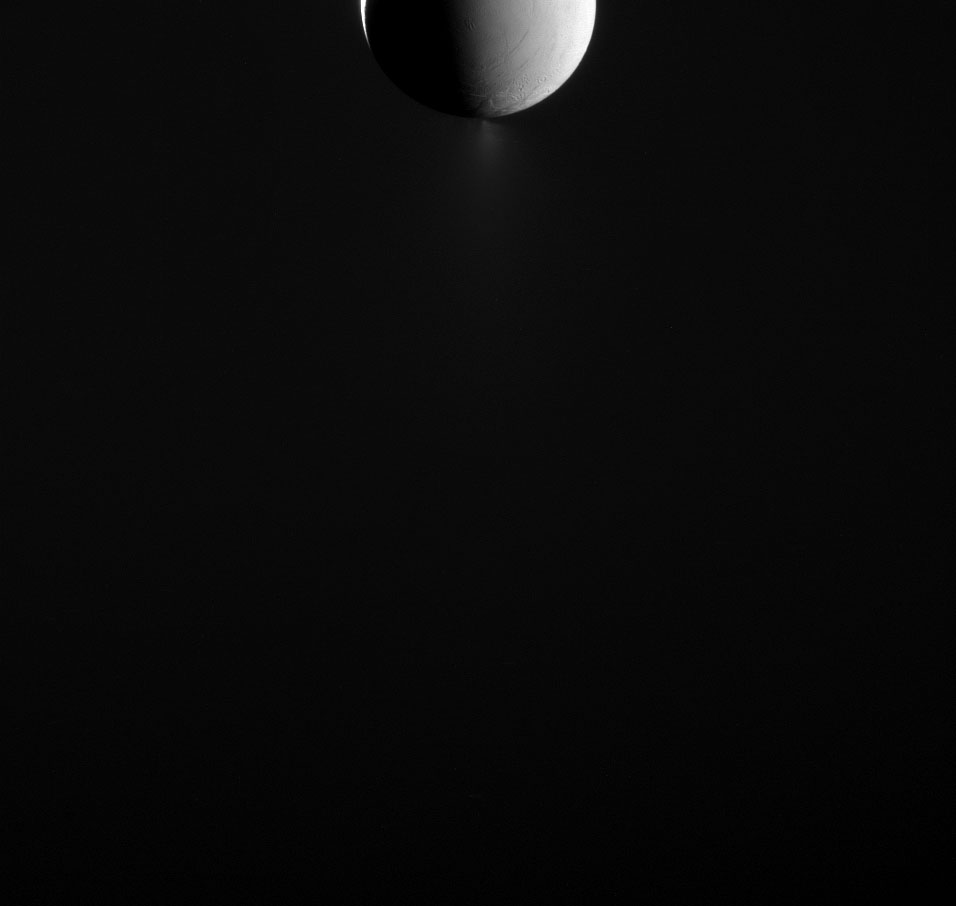
(source)
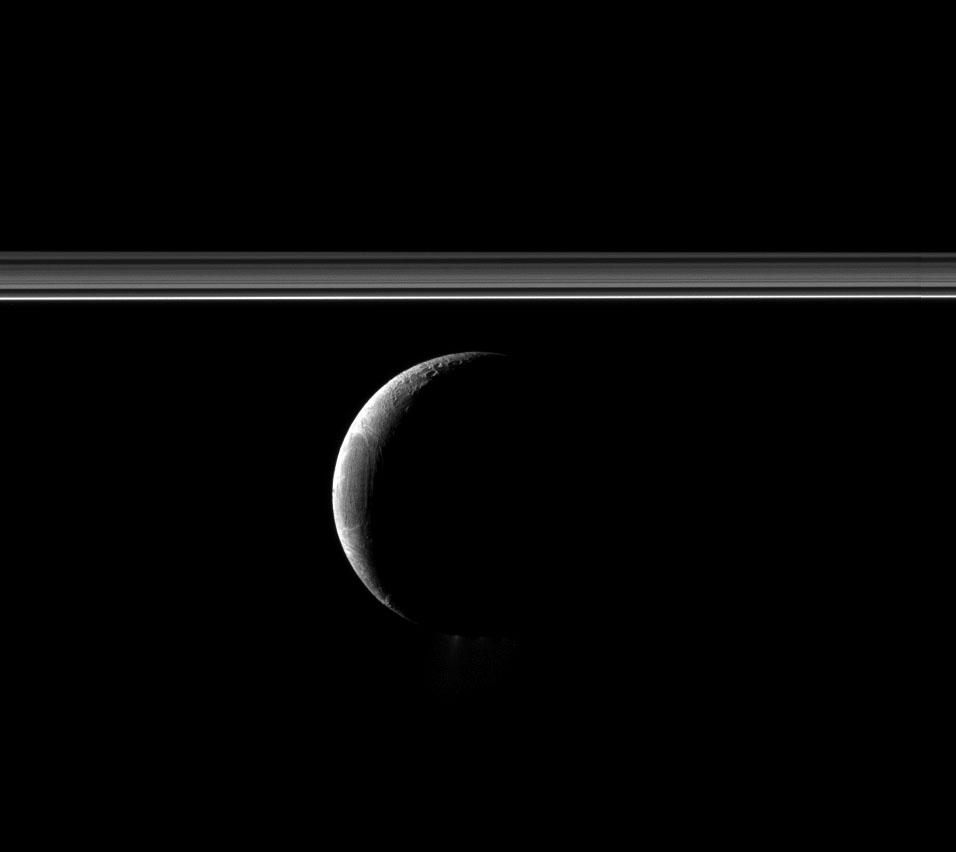
(source)
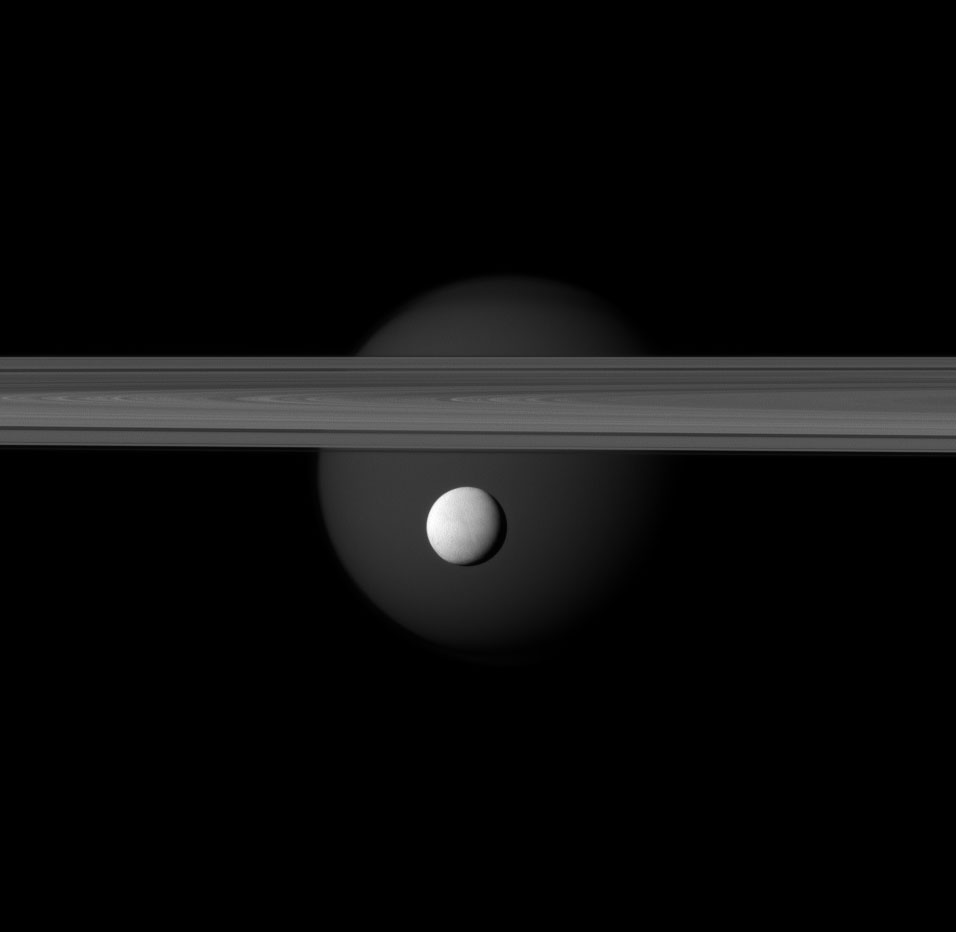
(source)
(Images by NASA/JPL-Caltech/Space Science Institute. That last one includes Saturn's largest moon, Titan, looming in the background.)
—has told astronomers that the slight wobble they can see in the moon, small though it may be, can only be possible if the moon's core is not connected to its icy crust—that is, if a global ocean under the crust completely separates the surface from the moon's solid center: "If the surface and core were rigidly connected, the core would provide so much dead weight that the wobble would be far smaller than we observe it to be."
It has been evident that liquid water exists on Enceladus for a while—at least since Cassini spotted geysers shooting into space from one of the moon's poles—but there was a debate on just how much liquid water there was—possibly it was just a sea beneath the pole. That theory no longer appears to hold enough water!
|
·····
|
| |
| A*, Dione photos; Skylab haircuts sucked | Aug 22, 2015 2:30 AM PDT | url |
| | |
Added 1 new A* page:I've been wanting to get a little messy and today's page...got more than a little! The secret, apparently, is to do everything wrong the first few times.
The ESA has some crazy new photos of the supermassive black hole known as A* and the galactic core around it.
The Cassini probe is taking "Farewell" pictures on its last tour around the Saturnian system before it intentionally plunges to its doom in 2017. It just took some nice last photos of Saturn's moon Dione.
In microgravity on Skylab in the '70s, a haircut involved close contact with scissors and a vacuum cleaner simultaneously.
Have a nice weekend, people. Be cool to each other.
|
·····
|
| |
| Solar system lousy with subsurface oceans | Mar 17, 2015 10:32 PM PDT | url |
| | |
Added 1 new A* page:You'll recall that in episode 23, Selenis traveled to a planetoid where a fairly thin layer of ice covered a subsurface ocean. This was inspired by evidence pointing to the possible existence of oceans under thick ice layers on a number of the moons in our solar system!
Saturn's moon Enceladus is famous for its spectacular geysers shooting water ice crystals into space, photographed as far back as 2005 by the Cassini probe:
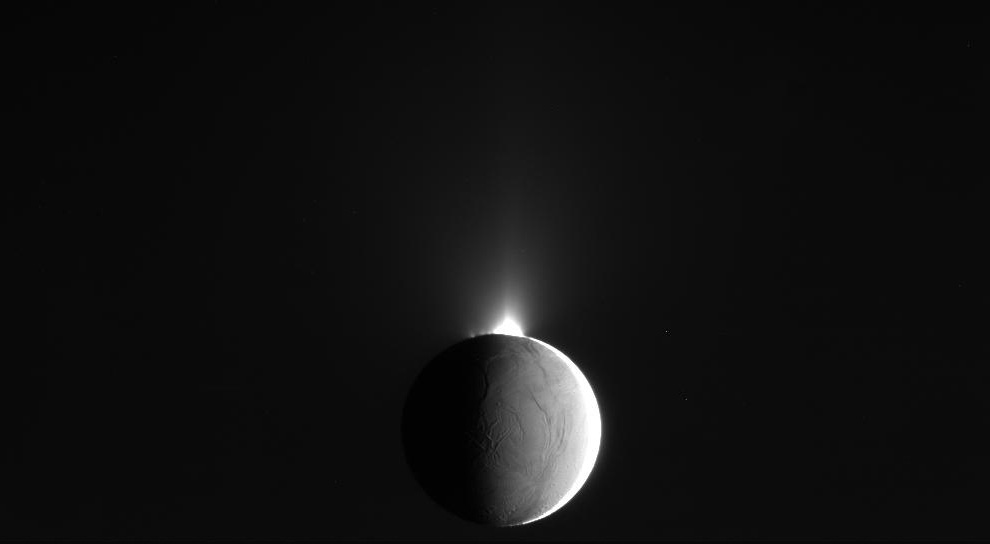
Cassini found that the ejected ice particles contain salt, pointing specifically to a salty subsurface ocean.
Last April, scientists reported an anomaly in the effect of Enceladus' gravity on Cassini's motion in the passes it has made near the moon, specifically past the south polar region, where geysers emerge from four "tiger stripe" gashes in the icy crust; a large depression covers the south polar region, which should weaken the gravitational effect felt by the probe as it flies past, but the effect was not as pronounced as expected, and the scale of the difference from the expected reading could be accounted for by the existence of something under the ice, denser than ice, though not as dense as rock—and water fits that bill: calculations "suggest a large, possibly regional, ocean about 6 miles (10 kilometers) deep, beneath an ice shell about 19 to 25 miles (30 to 40 kilometers) thick." Cassini is due to make more passes over Enceladus later this year.
NASA has also been allocating funds to study the possibility of a subsurface ocean beneath the crust of Jupiter's moon Europa. "The first hints of a subsurface ocean came from theoretical considerations of tidal heating (a consequence of Europa's slightly eccentric orbit and orbital resonance with the other Galilean moons)." Photos of the moon taken by the Voyager and Galileo probes showed terrain features that suggested upheavals from beneath the surface, where new ice formed in surface areas perhaps torn or melted apart, which could be consistent with tidal movements of an ocean beneath the ice. Mathematical models based on the theoretical heating and observed surface features "predicted that the outer crust of solid ice is approximately 10–30 km (6–19 mi) thick, including a ductile "warm ice" layer, which could mean that the liquid ocean underneath may be about 100 km (60 mi) deep"; "this leads to a volume of Europa's oceans of 3 × 10^18 cubic meters, slightly more than two times the volume of Earth's oceans." Furthermore, Galileo, which orbited Jupiter from 1995 to 2003, found that Europa responded less than expected to the force of Jupiter's powerful magnetic field, which could be accounted for by "a highly electrically conductive material in Europa's interior" that would intercept Jupiter's field and conduct it around rather than through the rest of the interior; "the most plausible candidate for this role is a large subsurface ocean of liquid saltwater."
In December 2013, the Hubble Space Telescope detected water vapor above Europa's south polar region, strongly suggesting the presence of water geysers roughly equivalent to those on Enceladus. Then, last September, scientists studying Europa's surface features announced that they'd discovered evidence for subduction—that is, for shelves of ice being shoved down below the surface by collisions with nearby ice plates, similar to plate tectonics on Earth. This kind of movement could be facilitated by a subsurface ocean of the type suggested by the earlier evidence.
Jupiter's largest moon, Ganymede, has been considered a candidate for a subsurface ocean ever since such a feature was suggested by scientific models of the moon's composition calculated in the 1970s. And the Galileo spacecraft, as it had found with Europa, noticed a weaker than expected response to Jupiter's magnetic influence, again suggesting a conducting subsurface ocean (Galileo had a similar finding for another of Jupiter's moons, Callisto).
And just a few days ago, news emerged of Hubble data providing the "best evidence" yet for the existence of a subsurface ocean on Ganymede: aurorae at Ganymede's poles—ultraviolet light emitted by high energy particles caught in the interplay of magnetic fields between the moon and Jupiter—would normally be rocking back and forth by six degrees as the moon orbits the planet, but Hubble, watching them, observed a mere two degrees of movement in Ganymede's aurorae, and what could account for that difference would be a lunar subsurface ocean no deeper than 330 km: "The data are consistent with an ocean of a 100km thickness with a certain salt content of about 5g per one litre of water. But it could equally well be an ocean of only 10km but with 10 times more salt."
Those are the moons with the best evidence for subsurface oceans—but there's more! That last news article lists more suspects in what could be a very "soggy" solar system:
- Estimates of the dwarf planet Pluto's density based on Hubble observations suggest a large water ice content, and the "decay of radioactive elements" below the surface could melt that ice, "creating a subsurface ocean layer of liquid water some 100 to 180 km thick at the core–mantle boundary."
- In 2014, the Herschel Space Telescope observed water ice around the dwarf planet Ceres; models of the dwarf based its observed size and orbit again suggest a significant water ice density presence; "also, some characteristics of its surface and history (such as its distance from the Sun, which weakened solar radiation enough to allow some fairly low-freezing-point components to be incorporated during its formation), point to the presence of volatile materials in the interior of Ceres"; "it has been suggested that a remnant layer of liquid water may have survived to the present under a layer of ice." The Dawn spacecraft, just arrived around Ceres, has observed "soft" surface features, suggesting a possible water ice composition.
- Based on density calculations, Saturn's largest moon, Titan, is thought to be 50% water ice. If its interior is still warm, a water/ammonia "magma" could remain liquid even at very low temperatures. The Cassini spacecraft has detected "natural extremely-low-frequency radio waves in Titan's atmosphere"; "Titan's surface is thought to be a poor reflector of extremely-low-frequency radio waves, so they may instead be reflecting off the liquid–ice boundary of a subsurface ocean." And gravity and visual observations by Cassini suggest that Titan's crust and core are moving independently, which would require a liquid layer of some sort separating the two.
- One explanation for the larger than expected wobble, reported this past October, observed by Cassini in Saturnian moon Mimas' orbit is a subsurface ocean, 15 to 20 miles beneath the surface. Mimas has been measured with a very low density suggesting a primarily water ice composition, but it is so small that while some theories say a more elongated ancient orbit could have produced enough tidal heating to melt the ice and form a subsurface ocean, others say that any such ocean would have refrozen long ago.
- Chemical and density calculations suggest a 30-45% water ice composition for Neptune's moon, Triton; water ice covers about 15-35% of its surface. "There is enough rock in Triton's interior for radioactive decay to power convection in the mantle. The heat may even be sufficient to maintain a subterranean ocean similar to that which is hypothesized to exist underneath the surface of Europa."
Whoa, that turned out to be way more subsurface oceans than I'd bargained for when I started writing this! : o
|
·····
|
| |
| Saturn Snowball; Martian Glass; Billion Stars | Feb 01, 2014 6:19 AM PST | url |
| | |
Added 1 new A* page:The last of the old news articles of potential interest from my mining of dailygalaxy.com a year or two back:
Apr 24, 2012: Mystery Objects Revealed in Saturn's Rings by Cassini Space Probe - Small moons and the like disturbing Saturn's F ring can cause the formation of half-mile-across "snowballs," which slowly (4 mph, or 2 m/s) drift through the ring, leaving glittering ice particle trails that can stretch over 100 miles
Apr 26, 2012: Dark 'Seas' of Glass Hint at Mars' Subglacial Lakes --Hotspots for Microbial Life - "Dark regions covering more than ten million square kilometers in the northern hemisphere of Mars" are composed largely of small, sand-like glass particles, possibly the result of magma mixing with ice or water during explosive volcanism. "Such geological features are not unique to Mars. Iceland boasts thousands of square miles of volcanic desert dominated by glass sand."
Apr 27, 2012: Image of the Day: A Billion Stars of the Milky Way - Talks about the gathering of data for this interactive viewer of a mosaic image of about a billion stars of the Milky Way, compiled by the Wide Field Astronomy Unit of the University of Edinburgh from sky survey data. Fun to zoom in and see what you can find! For instance there's a neat "little" pink nebula just a little to the right of the large central rectangular area.
~~~~~~~~~
One of the things I realized after I'd finally made myself stop poking away at today's A* page with watercolor and ink was that my favorite parts of it--the back part of the guy's right sleeve, and the bottom of his shorts--also happened to be the parts where I'd laid down just a really thick layer of watercolor wash on the surface of the paper, and let it dry--and what happens then I guess is that you get this nice smooth, slightly speckly fill with a thin, sharp, intensely saturated rim around it, where the pigment in the watercolor has condensed along the sides of the drying puddle of water, and it looks really cool, and even does a nifty version of that dark edge shading I was talking about yesterday for you automatically, and way more precisely than you could possibly do by hand; the parts where I went in drier with the brush and tried to do various kinds of graduated shading with layered brush strokes, like around Selenis' shoulders, don't look nearly as keen and smooth. This week it's gradually become clearer to me that a key to watercolor is to go in really wet--it's just scary to do that as a beginner. Hm and now I'm remembering that I *did* go in wet at first around her shoulders on this page, only then I got scared and blotted it up. Hafta remember not to wuss out next time!
Huh and speaking of wetter watercolor, I still have some of the fancy watercolor paper I used for ink wash for a while--episode 15, page 25 was the last page where I used it; at that point I got fed up with how it would warp under a heavy wash and get hard to scan. But there are heavier versions--although these would cost $3 per A* page, just for the paper! : P--and board-mounted versions, and alternatively, spraying the back of the page with water might help flatten them out. (You're supposed to pre-wet watercolor paper, then fasten it down somehow so it will stretch as it dries (and tries to shrink)--but that's kind of a pain. : P) Anyway, the watercolor paper has an additive called "sizing" that makes it less absorbent, so you can wash the colors around more easily, leaving less of the dry streaky lines you may get otherwise; also, supposedly it causes more of the pigment to sit on the surface of the paper rather than soaking into the interior, thus keeping more of color intensity as it dries. I never actually tried it with watercolor, though! Maybe I'll run around to art supply stores tomorrow and see if I can get some heavier samples to experiment on.
|
·····
|
| |
| The vortex of Saturn's hexagonal polar storm | Dec 01, 2012 8:40 AM PST | url |
| | |
Added 1 new A* page:A hexagonal storm 8,600 miles on a side surrounds the north pole of Saturn; heretofore that pole had been shrouded in night, so the storm could only be seen in rather blurry infrared photos taken by the orbiting Cassini probe; now, however, the Sun has reached the pole, and Cassini has been able to snap some vivid close-ups of the vortex at the center of the mysterious storm--a whirling hurricane perhaps some 1000 miles across:
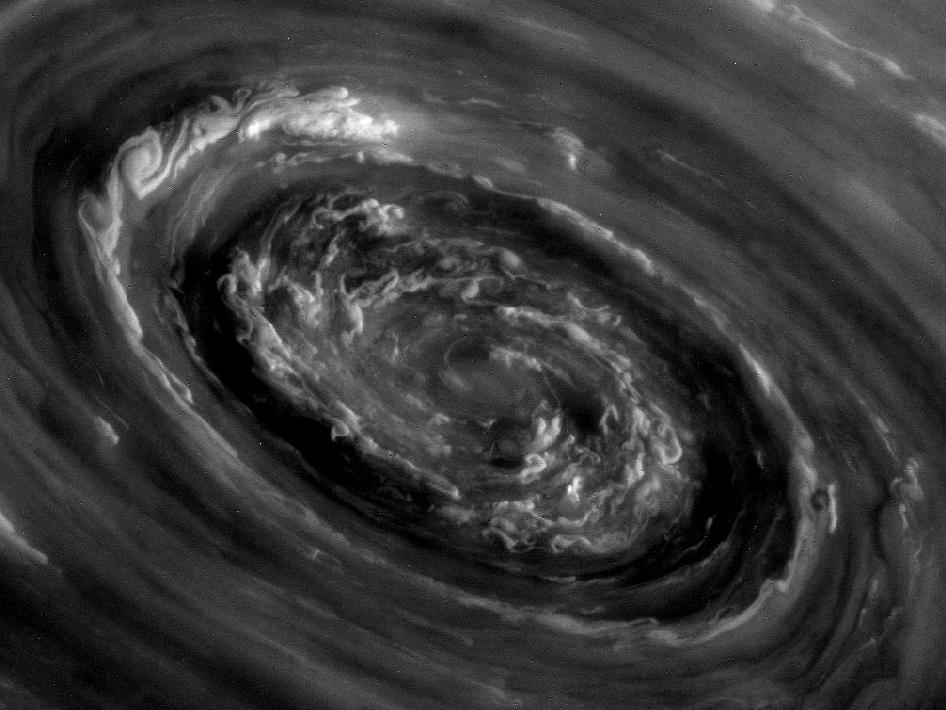
image by NASA/JPL-Caltech/Space Science Institute (source)
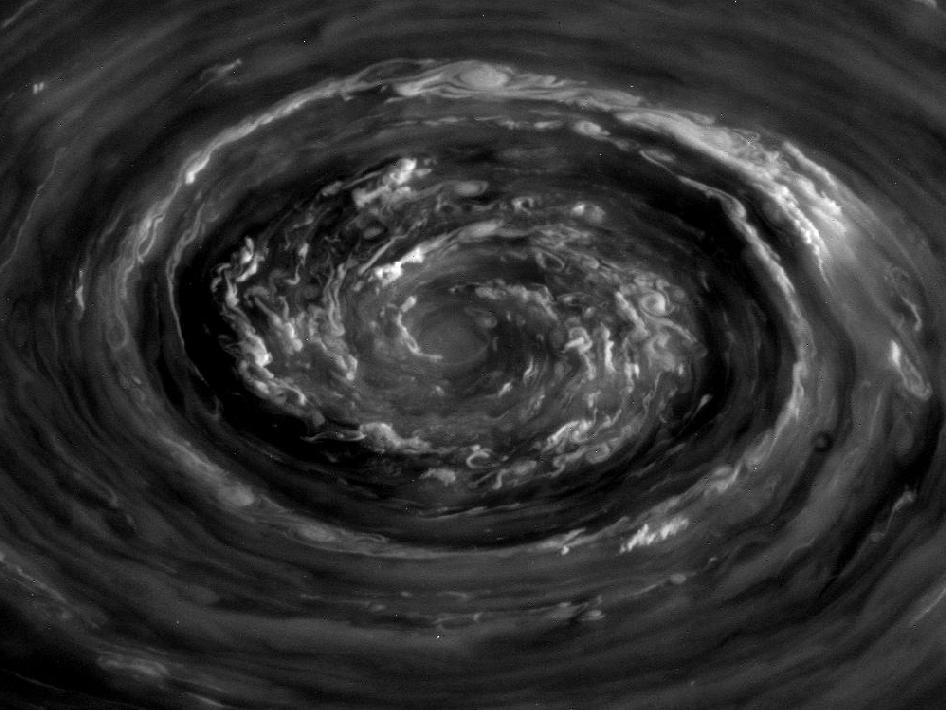
image by NASA/JPL-Caltech/Space Science Institute (source)
And a wider view:
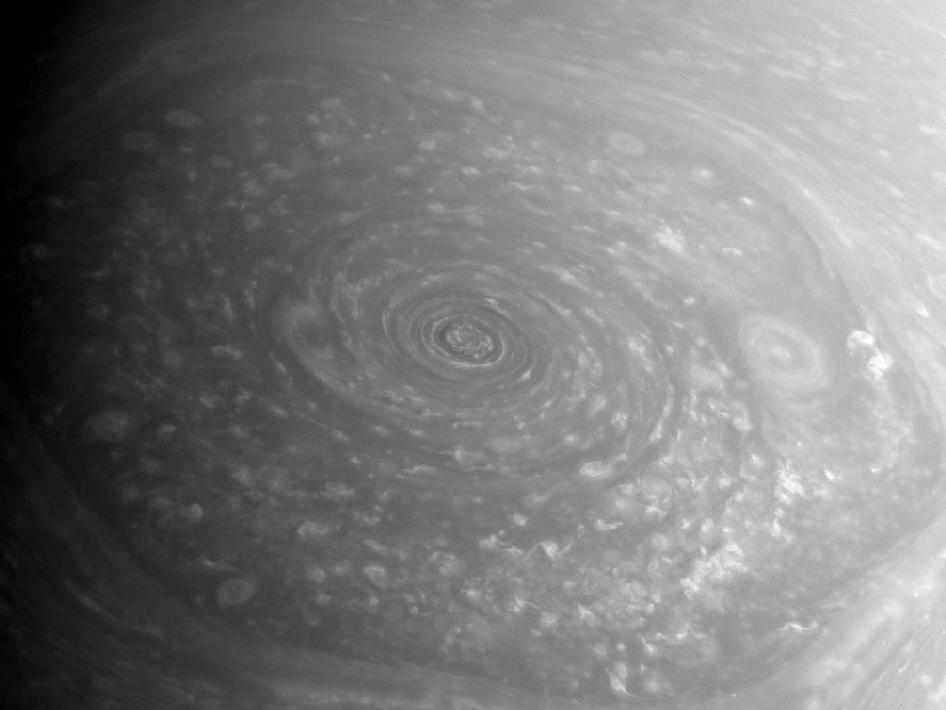
image by NASA/JPL-Caltech/Space Science Institute (source)
You can compare those against the infrared Cassini photo I posted when I talked about the storm back in January. The reason for the hexagonal shape is still a mystery! Here's NASA's article on the new photos.
|
·····
|
| |
| Saturn moon photos, CLASH, and rogue planets | Nov 17, 2012 5:06 AM PST | url |
| | |
Added 1 new A* page:How about some nice recent-ish Cassini photos of Saturn and its moons?
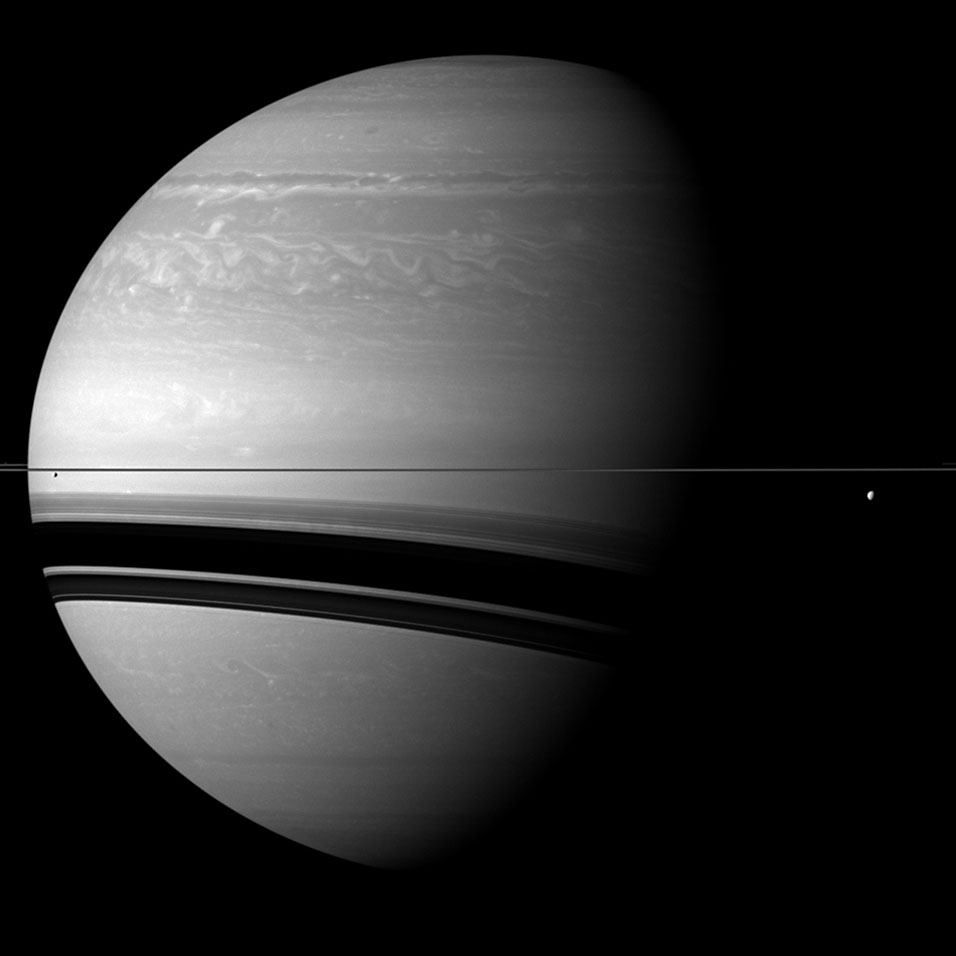
image by NASA/JPL-Caltech/Space Science Institute (source)
^ Saturn and three of its moons are pictured in this photo from last December. Enceladus (313 mi / 504 km diameter) is the one on the left, below the rings, Tethys (660 mi / 1,062 km diameter) is on the right, and tiny Pandora (50 mi / 81 km diameter) is...well, can you spot Pandora? It's just a little tiny speck right above the rings on the far left.
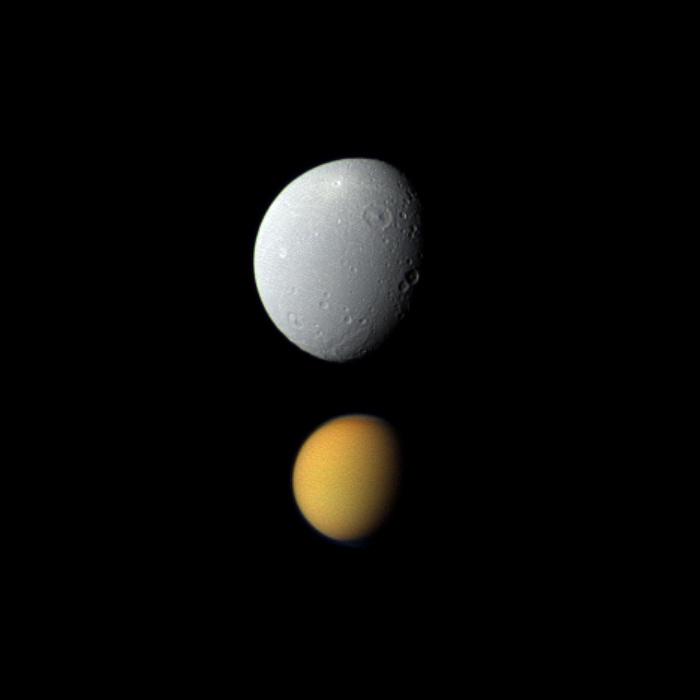
image by NASA/JPL-Caltech/Space Science Institute (source)
^ That's Saturn's third-largest moon, Dione (698 mi / 1123 km across), seen in front of the planet's largest Moon, the yellow cloud-shrouded Titan (3200 mi / 5150 km across).
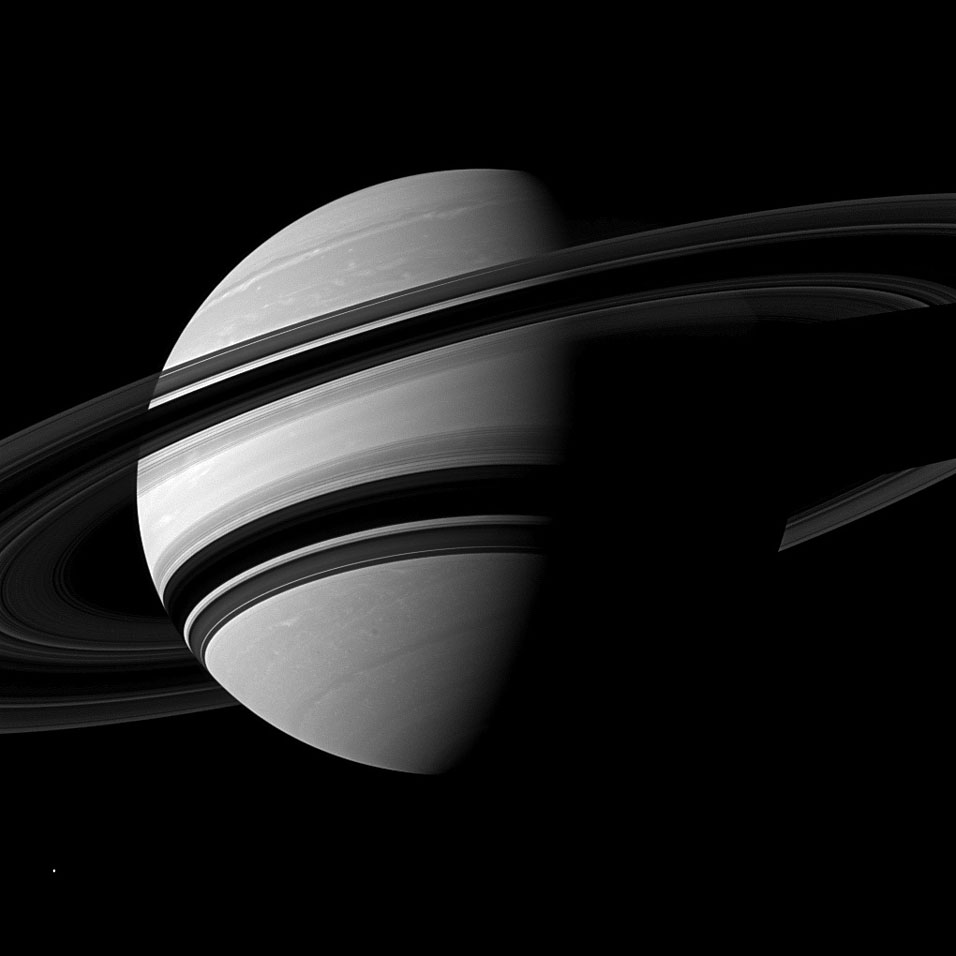
image by NASA/JPL-Caltech/Space Science Institute (source)
^ This photo from June has Enceladus again! Maybe they like getting that one in photos because it's all icy and bright and shiny.
There's a similar photo of Saturn and its moon Mimas from about a week and a half ago over here.
~~~~~~~~~
NASA's Hubble and Spitzer telescopes just zeroed in on what the galaxy-hunting project CLASH ("Cluster Lensing And Supernova Survey with Hubble") thinks is the most distant, and thus the earliest, galaxy yet seen: the extremely faint reddish blob known as MACS0647-JD is postulated to be a galaxy seen just 420 million years after the Big Bang, its light having traveled 13.3 billion years to reach us. What's particularly remarkable about the galaxy--not that much else can really be told about it, given that this is at the very extreme edge of our detection abilities--is its size: just 600 light years across! Theory says that a typical galaxy of that age should be 2000 light years across; for comparison, our Milky Way galaxy, thought to be a fairly typical modern galaxy, is 150,000 light years across, and we have orbiting dwarf galaxies that are themselves over 10 times as large as MACS0647-JD. One theory is that the old, tiny galaxy represents a "building block" that would go on to form much larger galaxies through galactic collisions and mergers.
~~~~~~~~
The ESO announced the discovery of a free-floating planet about 100 light years from Earth. Object "CFBDSIR2149" (oy!) is estimated to be about 4-7 times the mass of Jupiter, with "an effective temperature" of about 430 degrees C; it would also be relatively young: a mere 50 to 120 million years old. Those numbers derive from more definite measurements taken of a cluster of stars, the "AB Doradus Moving Group," with which the planet appears to be moving through the galaxy, and with which it probably shares its origin.
Free-floating planets have been spotted--or, rather, suggested--since the 1990s, when telescopic capabilities were refined sufficiently to start picking out their tell-tale signs in the flickers and wobbles of neighboring stars. CFBDSIR2149 is the closest yet, though, and also the easiest to examine directly, since it isn't too close to a bright star. While CFBDSIR2149 may fall into that fuzzy "brown dwarf" classification area between planets and stars--ie, objects that aren't *quite* massive enough to ignite into stars--it's getting clearer and clearer that our galaxy must be filled with many such free-floating bodies; the article cites one estimate that there are twice as many free-floating planet-things in our galaxy as there are visible stars.
~~~~~~~~~
Today's page was originally a light brighter:

But after uploading it and looking at it there for a while I finally realized it didn't have the shadowy dramatic impact I'd meant it to have. So I cracked open another ink bottle. :)
|
·····
|
| |
| Titan, the glow-in-the-dark moon | Nov 02, 2012 6:05 PM PDT | url |
| | |
Added 1 new A* page:Scientists have found that Saturn's moon Titan glows in the dark:
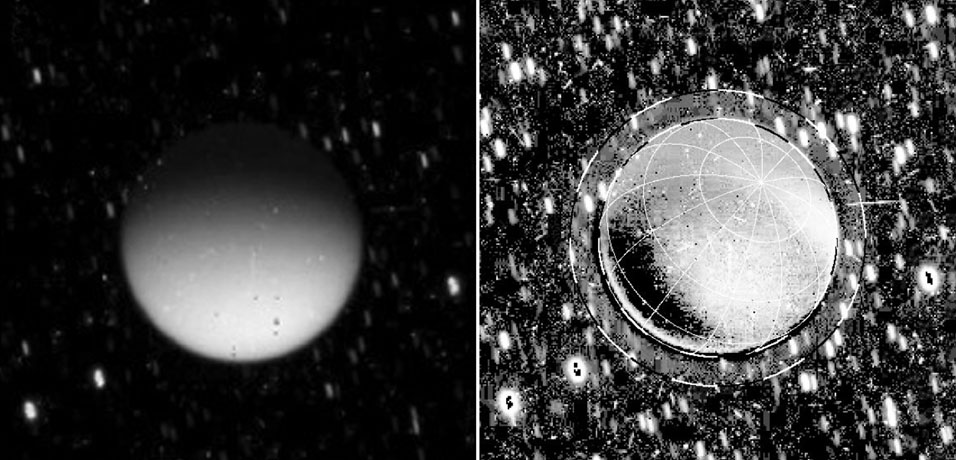
image by NASA/JPL-Caltech/SSI (source)
| This set of images from NASA's Cassini spacecraft shows Saturn's moon Titan glowing in the dark. Titan was behind Saturn at the time, in eclipse from the sun. The image on the left is a calibrated, but unprocessed image from Cassini's imaging camera. The image on the right was processed to exclude reflected light off Saturn and it is clear that even where Titan did not receive any Saturnshine, it is still emitting light. Some light appears to be emanating from high in the atmosphere (noted by the outer dashed line at about 625 miles or 1,000 kilometers in altitude). But more surprisingly, most of it is diffusing up from lower down in the moon's haze, from about 190 miles (300 kilometers) above the surface. |
The higher-altitude glow, a phenomenon called "airglow" in which "charged particles from the magnetic bubble around Saturn strip electrons off of atmospheric molecules at Titan" was expected; but the light coming up from lower down, although so faint it would be invisible to someone in Titan's atmosphere--it's estimated to be about a millionth of a watt--was unexpected and is, so far, unexplained.
One theory is that it comes from lightning; the planet Venus, for instance, glows with what's called Ashen light from lightning--it was first spotted there in 1643! But while lightning is known to occur on Saturn, it's never been seen on Titan, so the possibility exists that this moon's very faint light is due to something else entirely.
|
·····
|
| |
| A hot & strange Saturn storm | Oct 26, 2012 5:15 AM PDT | url |
| | |
Added 1 new A* page:A friend of mine pointed me over to this new NASA article with some analysis of the big white storm on Saturn that started in 2010. Such storms only happen every 30 years or so on Saturn, and this is the first one we've been able to observe up close, thanks to the Cassini probe orbiting the gas giant. The storm, which covered a range of latitude on Saturn as tall as North America and grew to wrap around the entire planet, dissipated in 2011; you can see the still large remnants as a bright swirly red and yellow cloud band in the upper part of this false-color Cassini photo from that year:
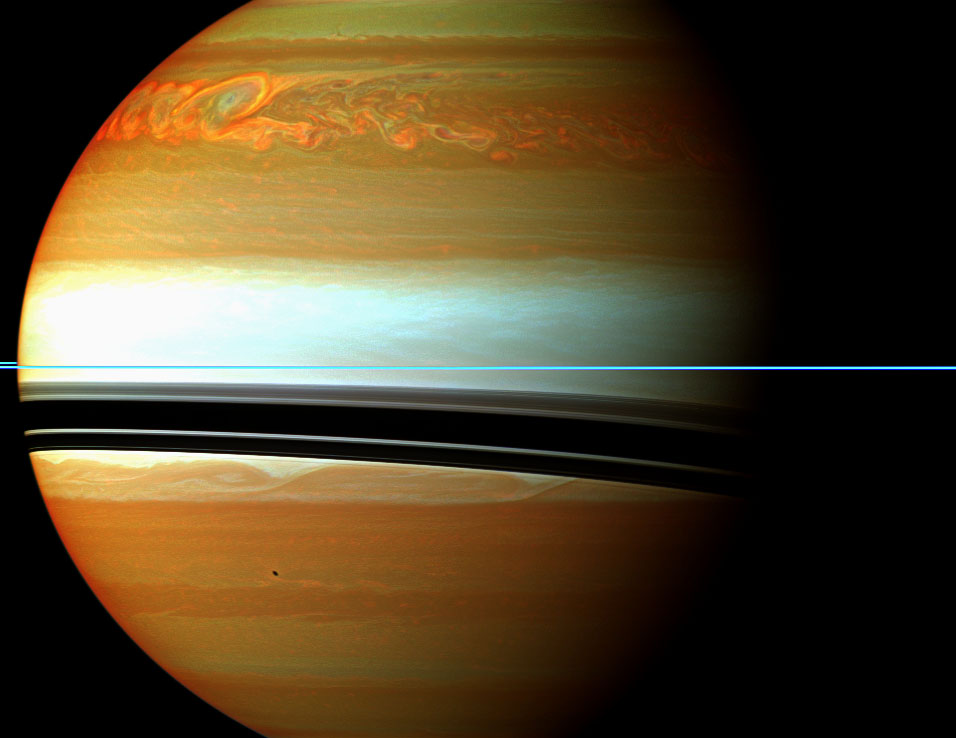
image by NASA/JPL-Caltech/Space Science Institute (source)
Crunching Cassini's readings of the storm shows that it was up to 150 degrees warmer than normal for Saturn's stratosphere; it also contained vast amounts of ethylene gas, which normally isn't seen on Saturn--its origin is a mystery.
The NASA article has some more info and a partially goofy movie about the storm, and this A* article from last November has a time-lapse photo sequence showing the storm's year-and-a-half lifespan.
~~~~~~~~
The Guardian just posted a pretty cool Voyager 1 and 2 photo gallery, with some great photos from the creation, launch, and early solar system exploration of those two space probes--now pushing the known boundaries of our solar system--from their youthful days back in the 70's and 80's. I got the link from this tumblr post.
~~~~~~~
I ran across a blog article thing about a NASA proposal to use solar electric propulsion to explore the inner solar system; solar electric propulsion, or "SEC," works by "generating electric power from solar arrays which is used to give a positive electric charge to atoms inside a chamber which are thrust out by magnets." This would allow spacecraft to have a long active lifespan; the trick is to find a way to generate the sufficient power from solar panels.
~~~~~~~~
Tried staying loose with today's page--thought I got a little too uptight with parts of Val yesterday. :P
|
·····
|
| |
| Saturn's chaotic moon: Hyperion | Sep 25, 2012 4:13 AM PDT | url |
| | |
Added 1 new A* page:Saturn's moon Hyperion (the Titan of "watchfulness and observation" in Greek mythology) was the first known non-round moon when it was discovered in 1848--which was some feat, considering that this irregularly shaped, dark, and highly pockmarked moon only averages about 270 km in diameter (it's about 360 km from tip to tip along its longest axis). It kinda looks like a potato in photos taken by the Cassini probe (this one's from 2005):
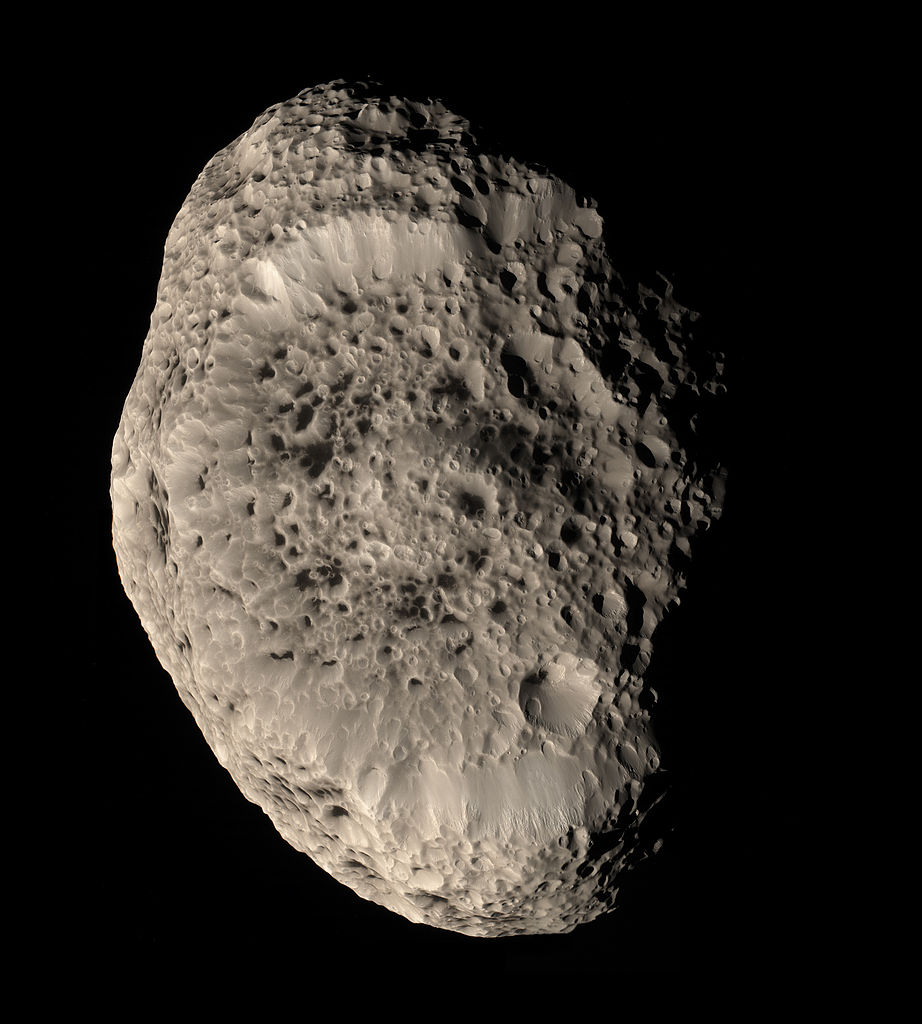
image by NASA (source)
It is the largest irregular moon of which we have good pictures--Neptune's faceted Proteus is larger, but hasn't been seen clearly yet. Hyperion has a very low density: calculations based on its size, orbit, and so forth estimate it to be composed mostly of water ice rather than rock--the dark color is thought to come from a thin coating of dust--and to be as much as 46% empty space, what with all those honeycombs of craters and so on, which have caused the moon to be likened in appearance to a giant sponge.
This strange potato sponge moon is also the only moon in our solar system known to rotate chaotically: likely because of its irregular shape, eccentric orbit, and proximity to Saturn's largest moon, Titan, Hyperion's axis of rotation wobbles so much that its orientation at any particular time is hard to predict.
Unique as it is, Hyperion is just one of 61 confirmed moons of Saturn! About half of them are distant, tiny things under 10 km across, but still!
|
·····
|
| |
| Enceladus & star flybys, Black Hole pinball | Apr 18, 2012 1:21 PM PDT | url |
| | |
Added 1 new A* page:Another page, another planetoid! I keep wanting to do one that's, well, not spherical or elliptical, but having done some "research" around Wikipedia today, I think I've finally managed to convince myself that gravity more or less make that impossible--at least if you want to have something large enough to have gravity that holds people to the floor, which I do in this case.
So it had to be roundish. But I still wanted to distinguish its presentation visually in some way from the other similar roundish bleak planetoid thingies I've done in the past. I was looking up some photos of pretty much my favorite moon, Enceladus, and noticed something (this is a cropped repost of part of a set I posted ages ago on the forum):
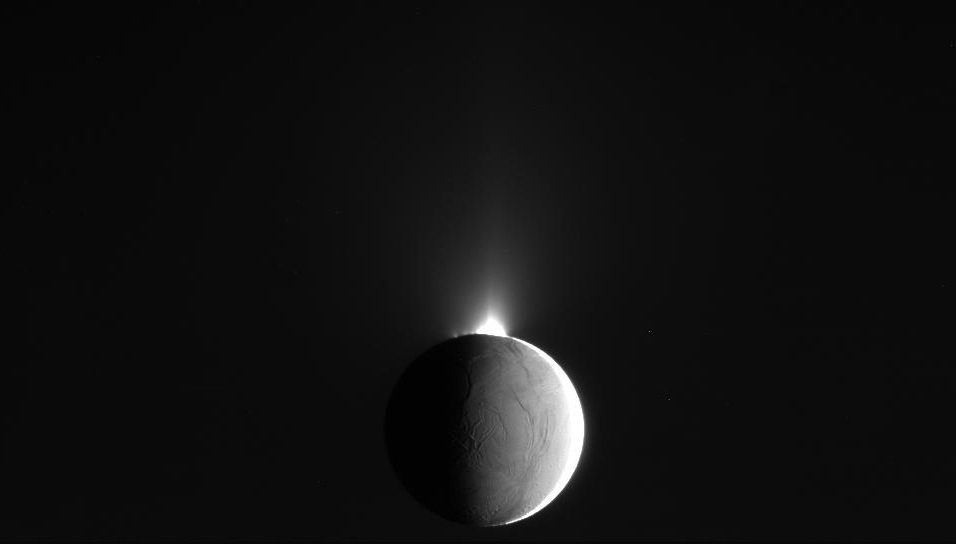
image by NASA (source)
Atmosphere! Actually it's clouds of ice crystals ejected from the moon's cryovolcanoes that now form a faint, thin ring among the many other rings around Saturn. I wanted to do an icy world anyway so I thought I'd go with that nifty space atmosphere look. Wikipedia's page on cryovolcanism says the instances we think we know of cryovolcanoes are thought to get their energy from tidal friction, which is to say the mechanical stress induced on cryovolcanic moons by the gravity of their parent planet slinging them around--and I'm not sure that I want this particular planetoid here being a moon, *but* Wikipedia's page does leave hope for other mechanisms causing cryovolcanism: theoretically they could be powered by radioactive decay, or even a "sub-surface greenhouse effect" enabled by "translucent deposits of frozen materials."
Anyway, back to Enceladus. Here's a nice mosaic image looking south from its north polar region that gave me the idea for the lighting on today's A* planetoid (although I somehow got it exactly backwards in the initial stages but nevermind :p):
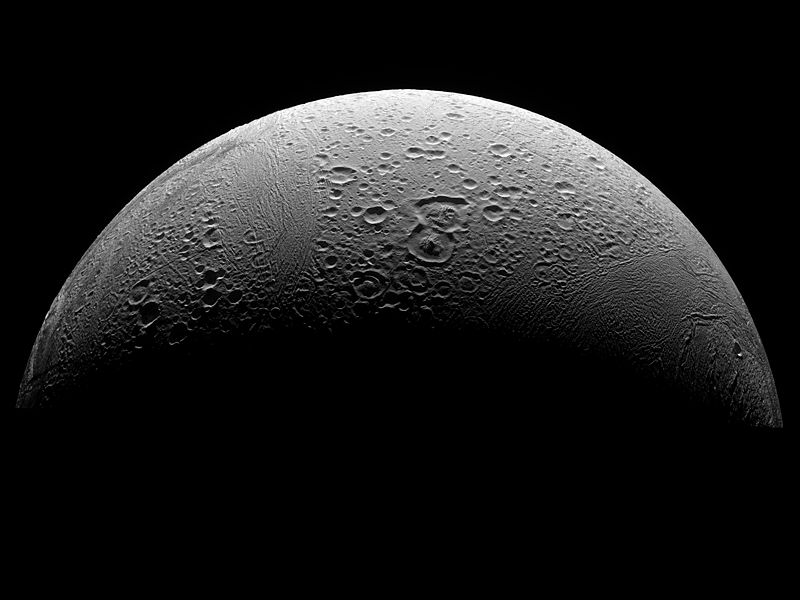
image NASA/JPL/Space Science Institute (source)
The three photos used in that image, like pretty much all the decent photos of Enceladus, came from the Cassini probe--a 2008 fly-by, in this case. But Cassini's still going, and in fact just did another flyby of Enceladus, passing within 46 miles of the surface a few days ago, on April 14th--it flew through some of the geysers of ice crystals shooting out of the moon's "tiger stripe" surface fractures. A fresh photo from that flyby helped give me the idea for showing a planetoid in nearly pitch-black aspect:
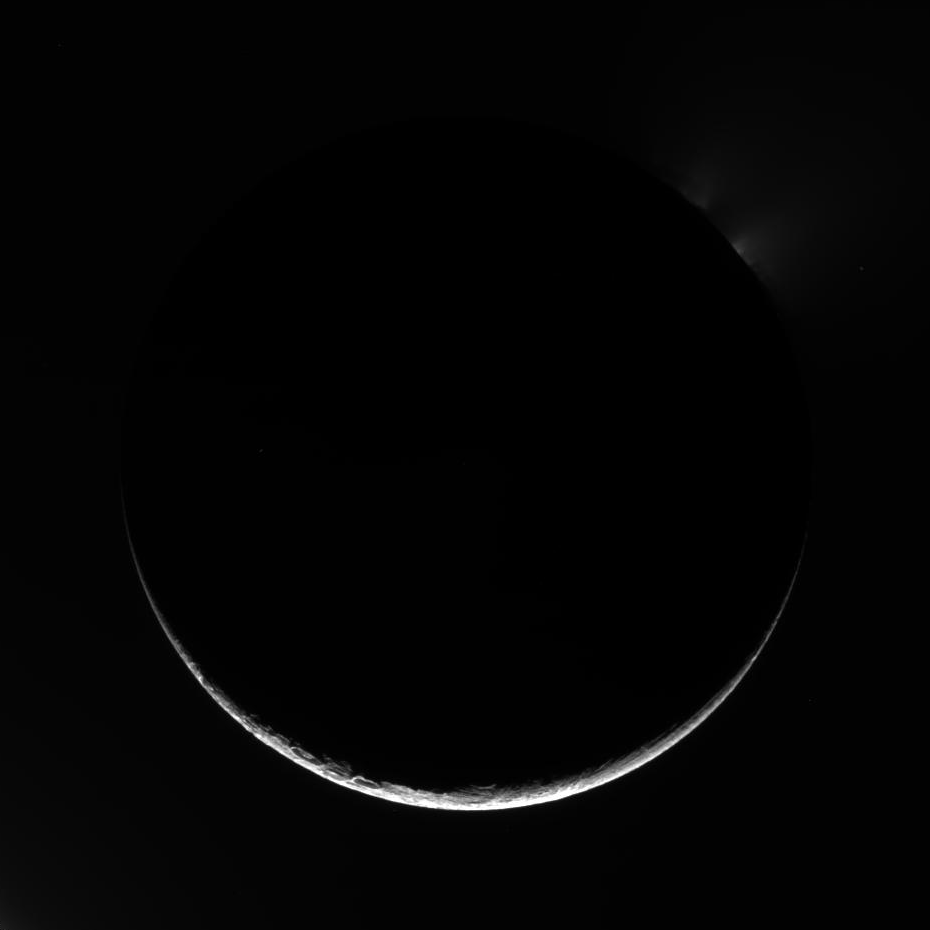
image by NASA/JPL/Space Science Institute (source)
~~~~~~~~~
I posted a few early stages of today's page to A*'s Twitter, Facebook, and G+ accounts as I was making them earlier today. Here they are and some later ones I haven't posted before now because they were causing me some consternation:
I probably should have stopped with this nice energetic initial outlay of black:

Or after the first ink wash to establish the "space atmosphere" effect:
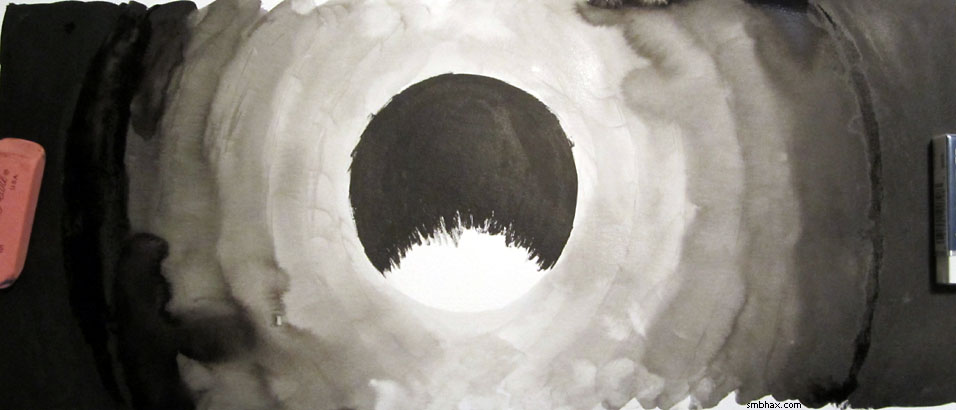
But I decided that was too bright still--I made this mockup in Photoshop from that ^ scan to convince myself going darker would be closer to what I wanted:
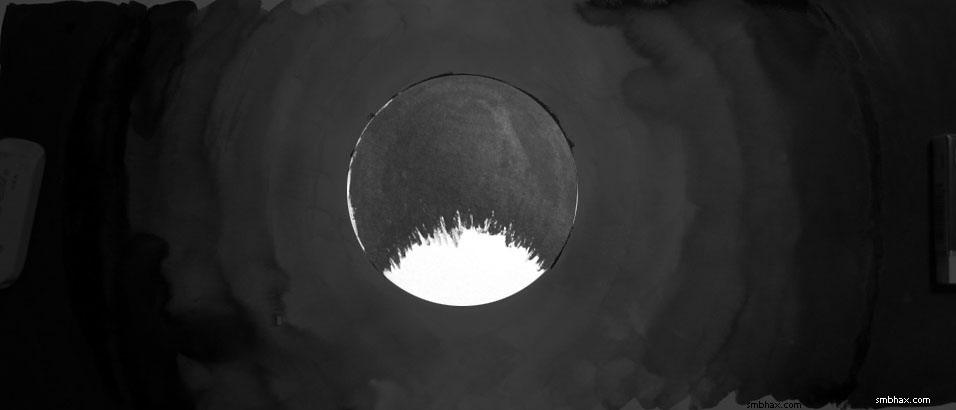
So after a bunch of washes and star spattering (had to use my old non-waterproof white ink for that--the gluey waterproof stuff tends to spatter in strands) and re-painting over the planet with straight waterproof ink which I figured would a) make it extra black and b) give it a bit of maybe ice-like texture from the shine using non-watered-down waterproof ink gives--the gleam of all that lacquer, you know, I had...a blurry, warped, wavy looking planet :P:
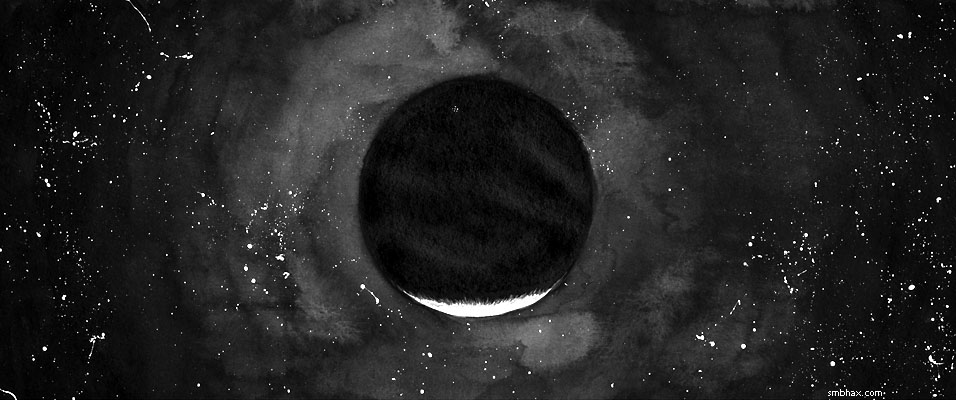
That was no good, so I tried dulling the gleam and straightening out the planetoid's profile with black marker, as well as sharpening up the horizon with a thin wash of the non-waterproof white ink:
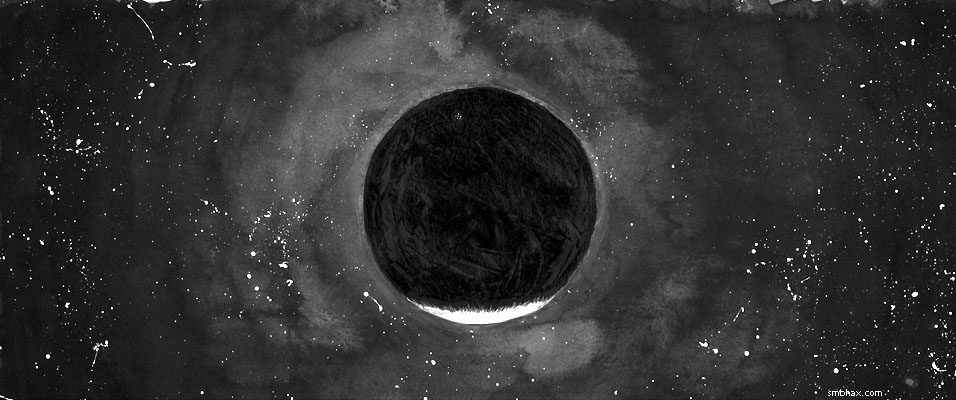
...which rather backfired, as I now had a super-dark planetoid full of marker-line gleams, and even less round than it had been. So I went back over it with watered-down black ink to kill the gleam, and, after using a Photoshop mockup with a computer-drawn circular overlay to show me where the not-so-round parts were sticking out (as I'd noticed was a side benefit from my earlier computer mockup), touched up the edges some more with marker and white ink wash, and finally white waterproof ink when I wasn't satisfied with the sliver of sunlit area I'd whittled it down to. And then wet down the back and squished it under heavy stuff on the scanner glass for a while until it decided to scan with a reasonably even black on the planetoid--which finally worked after some persuading, thank goodness. (Note to self: this is why you need to do that ink round-up and see if you can't find yourself a nice, really dark matte black ink. :P)
And that's just how simple it was to get the final version! :P
Good gravy I am bad at drawing round things that don't fit the sweep of my elbow or wrist. ;P I should smarten up and just use a protractor or jar lid or something, I suppose--but then what would I do with myself for the rest of the evening? :PP
This was also an interesting one in that I usually use Photoshop's "Auto Levels" function at default setting in my macro to recalibrate the scanned image to cover the full gamut from true computer black (ie RGB 0, 0, 0) to full white (RGB 255, 255, 255), so it doesn't look washed out just as a result of the scanner's lighting and capture ability, but doing that on this one made it come out way too contrasty--turns out Auto Levels' 0.5% black and white clip values (in my ancient 4.0 version of Photoshop, in the Auto Levels window, I have to hold "Alt" to change the "Auto" button to an "Options" button to see/change the clip settings--I didn't discover that until a month or so ago and have kind of been wondering about it ever since) were totally clipping past the stars and light part of the planet here, so the light end as a result was being boosted way too much, since it tried to make a full white out of probably some of the grayish atmospheric stuff around the planetoid. Checking in the significantly less ancient Photoshop CS2, the default clip values there appear to be 0.1%, which doesn't stomp the far ends of the value gradients nearly as much, so I guess I'd better use that in Photoshop 4.0 instead of 0.5% like I had been (which I *think* was the default, although I suppose I can't be sure since there's no way to reset it to the default, at least not within the program :P); the difference is scarcely visible in most of my pages, but for ones like this one (okay so this is the only one I've noticed it really needing tweaking on so far) where there are very few pixels at one end of the spectrum, it certainly makes a big difference. So! That...is good to know, and now my beloved ancient version of Photoshop is riiiiiight up to speed >_> and I can do more subtle shading.
~~~~~~
A neat Christian Science Monitor article at abcnews.com on supermassive black holes was shared with me on Facebook. Thanks, Dave! The article describes a theory of what supermassive black holes feed on, and where "hypervelocity" stars zooming out of our galaxy get their high speed--about 20 have been spotted since 2005--and these were predicted by Los Alamos astrophysicist Jack Hills back in 1988, who said that the tell-tale sign of a central supermassive black hole in our galaxy would be lone stars catapulting outward faster than 1 million miles per hour (light speed is about 671 million miles per hour, by the way).
The idea is that when binary stars fall too close to the supermassive black hole--and because they orbit each other at quite a distance, they only have to fall within about one Astronomical Unit (the distance from the Earth to the Sun, about 93 million miles) of A*, whereas a lone star would have to get as close as the distance between the Sun and Mercury, which is close to just a third of one AU--one of the pair gets stripped off by the hole's huge gravity, and flung outward at high speed. The other is pulled into a cloud of similar stellar "orphans" orbiting the hole; eventually, that cloud is disrupted when one star too many drifts in, and their own resulting gravitational interactions eventually result in one of their number plunging down into the supermassive black hole, which releases a mighty energy flare as the doomed orphan star is consumed. Such flares, "a so-called tidal disruption event," have been seen in the cores of other galaxies, and based on that, it is calculated that A* might eat a star and send out a flare "once every 1,000 to 100,000 years" (which seems like a rather wide range, but hey).
The new research behind this article had to do, I think, with calculations of just how much mass the black hole could expect to gain from this binary-eating mechanism: "it could explain how black holes in some of the largest elliptical galaxies, with central black holes of several billion solar masses, can bulk up when the galaxies they inhabit have so little gas to feed on." The researchers hope to refine their estimates as more sensitive telescopes let them spot more escaping stars.
(Nearly a couple years ago now, I made a news post about a similar theory--this one seeking to account for the existence of blue hypergiants flinging out of the galaxy, since their trip from the galactic center must have taken something like 100 million years, and blue hypergiants only live about 20 million years: the idea was that they actually come from trinary stars that drift too close to A*: A* pulls off one, violently flinging off the remaining binary, and then the two stars in that binary merge to form the hypergiant on their way out of the galaxy.)
~~~~~
Stretching the black hole topic even further, I've been playing a re-creation of a mid-80's Gottlieb pinball table, "Black Hole," in a new pinball game collection called "The Pinball Arcade"; it's available on all sorts of portable and otherwise systems--I've got the PS3 version. "Black Hole" was the first pinball table to cost a super-massive 50 cents--and as a result, it was the most profitable of all time, or something like that. These black holes, they're relentless I tell ya!
When you start a game on the Black Hole table, a computery voice ominously declares "NO ONE ESCAPES THE BLACK HOLE." The big gimmick is that you can get swallowed down into a small, reversed pinball table revealed beneath the glass floor of the main table; and that table is really tricky, so basically you want to get out as soon as you open the "gate" that will allow your safe "re-entry" to the main table. It's really scientific! Anyway here's a demonstration play by the game's creators, although it skips the start-up voice, alas:
video on Youtube
I'd like to think that if Gottlieb was still around, they'd release a "Supermassive Black Hole" follow-up, that would cost...eh...4 million times the mass of a regular table rather than just two times...where's my calculator...$1,000,000 per play! Ka-ching!
|
·····
|
| |
| Enceladus mosaic; 45 years from Apollo 1 fire | Jan 28, 2012 8:29 AM PST | url |
| | |
Added 1 new A* page:Thought I'd leave you for the weekend with this nifty false color orthographic projection of Saturn's moon Enceladus, constructed from a photo mosaic captured by the Cassini probe in 2008, just after it had flown within 25 km (15.6 miles) of the icy moon's cryovolcanoes:
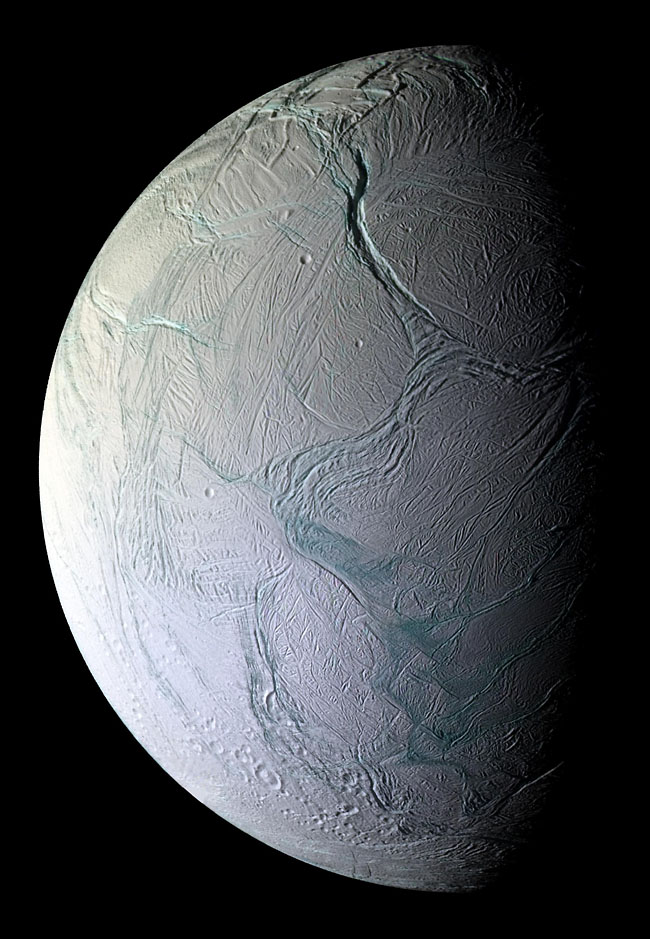
image by NASA/JPL/Space Science Institute (source)
Enceladus is a pretty rad moon that I've discussed on a number of occasions; this post has some nifty photos and links to more, for instance.
~~~~~
There's an extensive Scientific American article here about the Apollo 1 cockpit fire that killed three astronauts in 1967--exactly 45 years ago (to Friday). It has a lot of details I hadn't come across before. For instance:
- The engineers monitoring the fatal test were in a "White Room" module right next to the capsule--in fact, it was the hallway through which the astronauts entered the cockpit. So they could see the flames through the window in the portal of the capsule's inward-opening door, but were powerless to open it against the cabin pressure.
- The Soviet Union had experienced a very similar accident in 1961, when cosmonaut Valentin Bondarenko, after ten days in the "Chamber of Silence"--a sensory deprivation room used to train cosmonauts for the isolation of space missions--in removing the sensors attached to his body in preparation for leaving the chamber accidentally tossed the alcohol swab he had used to remove adhesive onto the coil of his hot plate. As with the Apollo 1 capsule, the room was pressurized with highly flammable pure oxygen, and the swab catching fire on the hot plate was enough to turn the room into an inferno that inflicted what would be fatal burns all over Bondarenko's body. The door to the chamber was opened quickly, and the normal atmosphere doused the pure oxygen fire, but it would prove too late to save Bondarenko, who was whispering apologies to the doctors as they pulled him from the room. The Soviet government hushed up his death until 1986.
- The US, even if it didn't know about Bondarenko's accident, had four oxygen fires of its own in the five years leading up to the Apollo 1 fire that could have served as warnings that a pure oxygen atmosphere was highly dangerous. Two of these incidents occurred in the Air Force, one in the Navy (dive unit testing), and one in the Apollo program itself--the two Navy divers were killed. But it took the deaths of the three Apollo 1 astronauts to teach the United States not to use pure oxygen environments.
|
·····
|
| |
| Alliteration hurricane; Saturn's south pole | Jan 27, 2012 6:24 AM PST | url |
| | |
Added 1 new A* page:That alliteration was almost all unintentional. >_>
So hey if you're like me, the huge hexagonal storm around Saturn's north pole that I talked about yesterday might have got you wondering what's the planet's south pole is like. Well it's kind of like this:
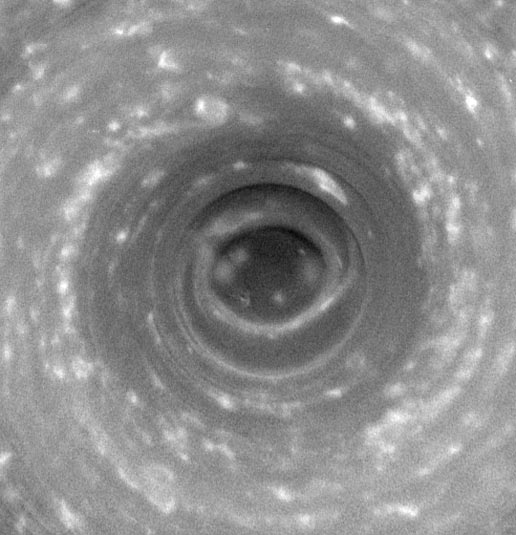
image by NASA/JPL/Space Science Institute (source)
According to the NASA/JPL page about it, that's a 8,000 kilometer (5,000 mile)-wide hurricane, its winds whipping 30 to 75 kilometer (20 to 45 mile)-high walls of clouds--those are "two to five times taller than the clouds of thunderstorms and hurricanes on Earth"--around at "550 kilometers (350 miles) per hour"--nearly twice the speed of the most powerful hurricanes recorded on Earth. You can even see a sorta movie of them (mpg format) on that page, compiled from a sequence of photos by the Cassini probe.
Oh, so just a hurricane 2/3rds of the Earth's diameter? Yep. :o Of course they don't really know what's causing it, and those dark clouds at the bottom of the eye are a mystery--they're about twice as deep into the atmosphere as we can usually see--but it could have something to do with the planet actually being "2 Kelvin (4 degrees Fahrenheit)" warmer at the pole. As some NASA dude put it, "the winds decrease with height, and the atmosphere is sinking, compressing and heating over the South Pole."
Man our planet's poles are pretty boring compared to Saturn's! Until we find the frozen ancient alien astronauts, anyway.
|
·····
|
| |
| Space hexagons and backwardsy forwards | Jan 26, 2012 4:44 AM PST | url |
| | |
Added 1 new A* page:Now what do you suppose this is?
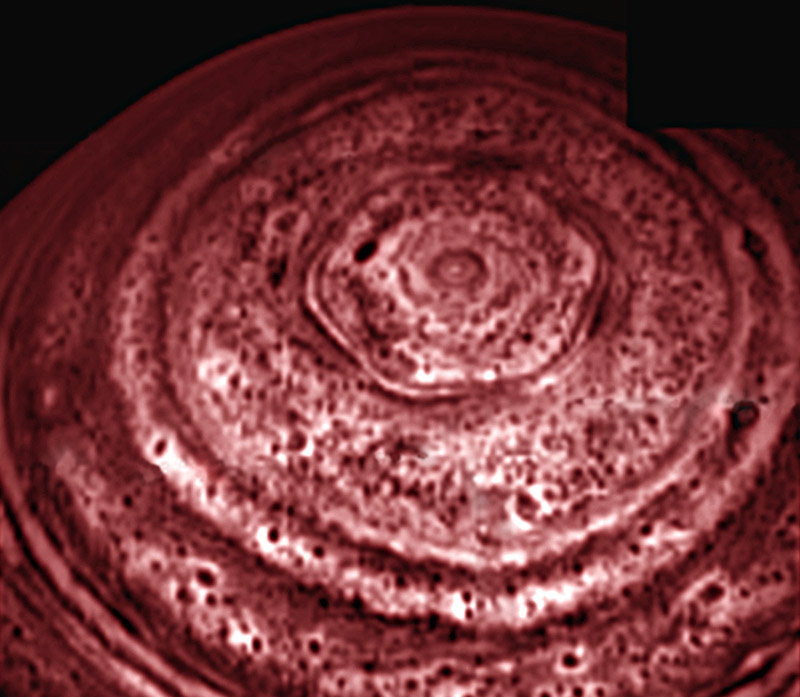
image by NASA/JPL/University of Arizona (source)
If you said it's the 25,000-kilometer-wide hexagonal storm system at Saturn's north pole, as seen by Cassini in infrared in 2007, you'd be right! (Good work! :D) According to NASA/JPL's article on it, the storm is at least a semi-permanent feature of the gas giant, having been spotted by the Voyager spacecraft in their flybys of the planet in 1980 and 1981. The light areas are a depression that drops some 100 km into Saturn's atmosphere. Check that article for more pictures and an animated sequence of its rotation, compiled from Cassini images.
Wikipedia has a little more on the hexagonal storm:
The entire structure rotates with a period of 10h 39m 24s, the same period as that of the planet's radio emissions, which is assumed to be equal to the period of rotation of Saturn's interior. [...]
The pattern's origin is a matter of much speculation. Most astronomers believe it was caused by some standing-wave pattern in the atmosphere; but the hexagon might be a novel aurora. Polygonal shapes have been replicated in spinning buckets of fluid in a laboratory. |
So yeah it's kind of a mystery, and just goes to show how little we really know of Saturn's inner workings.
~~~~~~~
I'd been kind of wondering how I was going to do a space scene in this whole ink wash thing I've been using for the comic lately, and in this case at least the answer was to go wet-on-wet and let the ink sort of run itself across the page to get some nebula-type action going. There were a few surprises but overall it seemed to work okay. When I did those sorta dark tendrils above the back end of the ship (the one with the probably exaggerated flame coming out :P) I was thinking of the Pillars of Creation, an intricate star-forming region in the Eagle Nebula captured in a rather spectacular and famous photo by Hubble in 1995.
Oh! And I don't usually do this but the sequence of this ship will be somewhat broken up so I thought I might as well give it a shot: the ship is shown here in the correct braking attitude, ie it is facing backwards, firing its main thruster to decelerate as it approaches its destination, which may be somewhere in the region of the big star on the right. I don't usually draw braking ships the correct backward way because it's kind of hard to tell which way they're going when you do that. Hm so this will just confuse the issue even more since I'm being inconsistent now. Oh well!
|
·····
|
| |
| Episode 15, Synthetic Aperture Radar | Dec 07, 2011 4:27 AM PST | url |
| | |
Added 2 new A* pages:Yay episode 15! This is Selenis 35, who we left on her way to the spaceport at the end of episode 13.
~~~~~
Seems like I'm always writing about Saturn's crazy ice-shooting moon Enceladus (the last time was back in October, for instance). That's partly because it *is* so crazy (shoots ice particles out into a ring around Saturn, is coated in up to 300 feet of snow, etc), and partly because the Cassini spacecraft is often cruising around there getting some amazing photos.
Now Cassini's broken out a new trick on Enceladus: capturing swaths of the moon's topography in extremely high detail with synthetic aperture radar.
This Synthetic Aperture Radar ("SAR") stuff is pretty nifty; I can't make heads or tales of the fairly technical Wikipedia page on it there, but it seems to involve getting really detailed image data back by bouncing radio waves off the surface, instead of just taking photos or something. Here's a killer image of the Venusian surface made using SAR data the Magellan spacecraft got in 1991 (the globe shape and color are simulated)--the radar imaging cut right through the incredibly thick cloud layer that completely covers the planet:
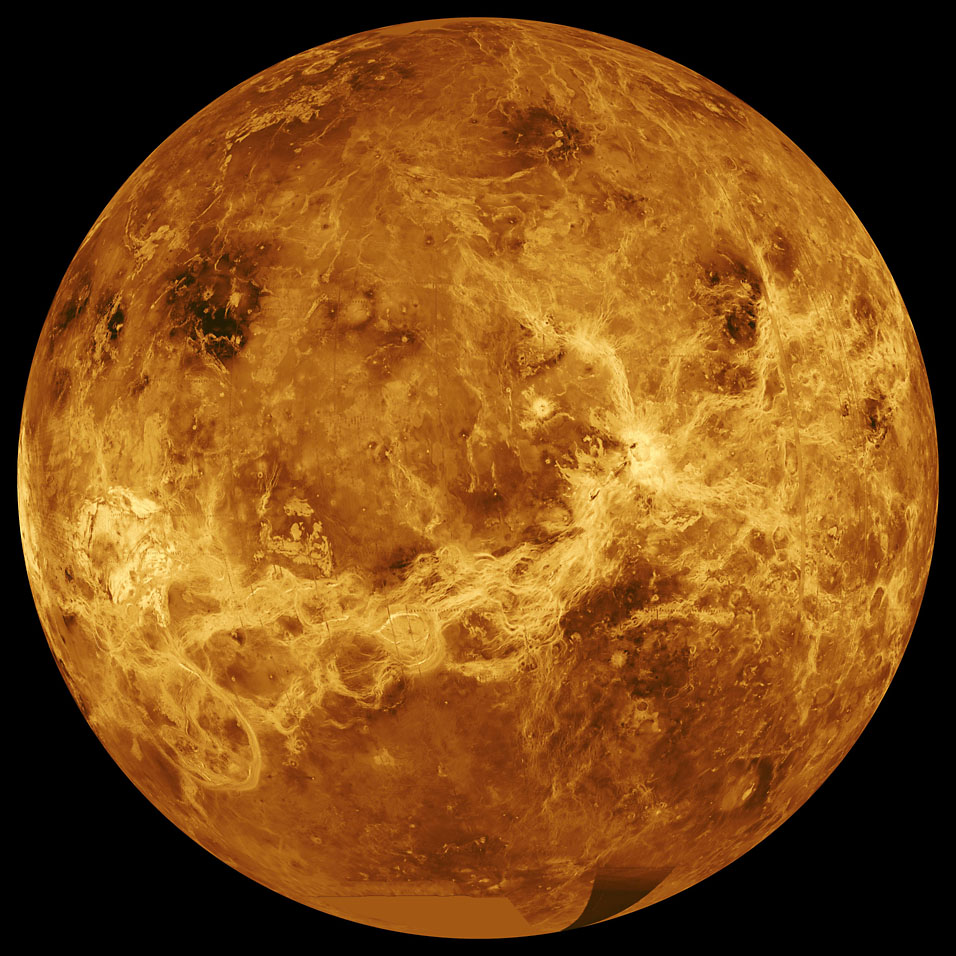
image by NASA (source)
|
·····
|
| |
| Episode 14, Moon maps, Saturn storms | Nov 19, 2011 10:32 AM PST | url |
| | |
Added 2 new A* pages:So if you didn't notice from the episode title page ;), this is a flashback episode. Don't worry, it'll be brief--only about twelve pages (not counting the title page), in fact. Also pretty punchy. It might just be the best episode EVER.
~~~~~~
NASA and ASU just released Moon-wide high-resolution maps taken by the Lunar Reconnaissance Orbiter. Here's a sample:
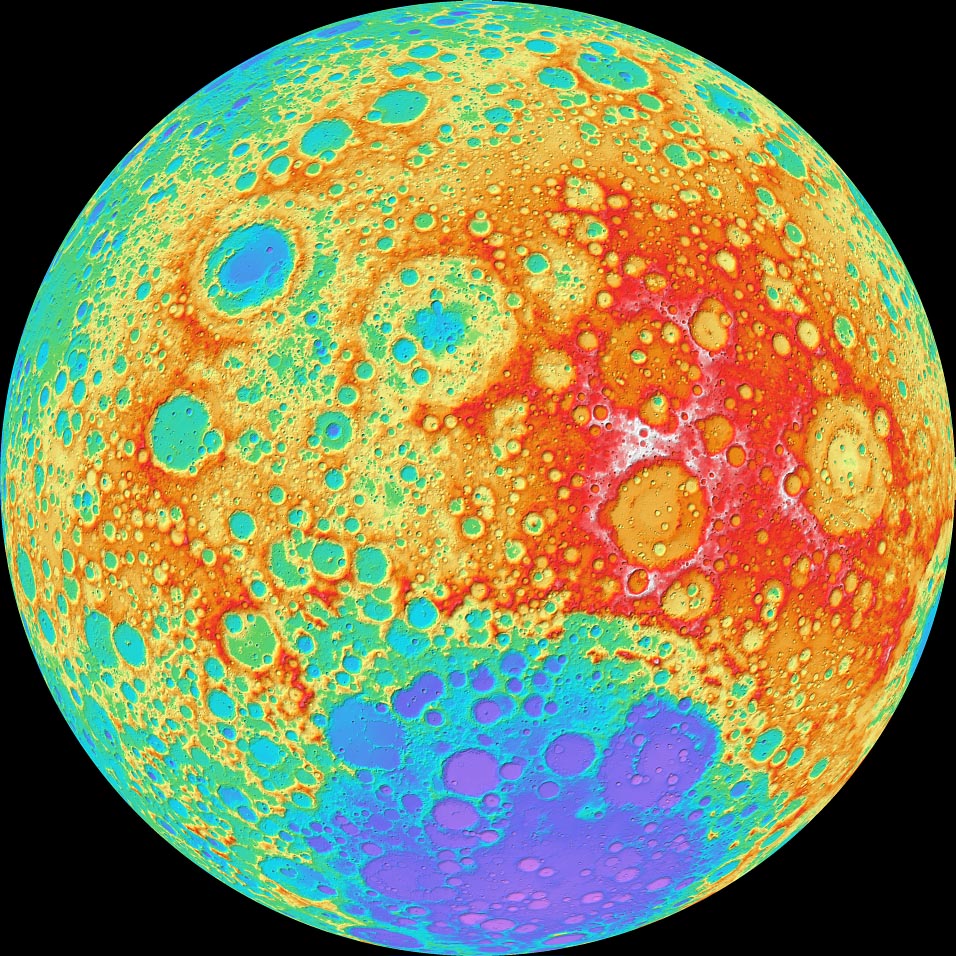
image by NASA's Goddard Space Flight Center/DLR/ASU (source)
You can get your own--at pretty much any size and angle--from ASU's LRO color-shaded relief map explorer.
~~~~~~
Photos of Saturn gathered by the Cassini probe have been put together to show the evolution of the longest-lasting storm ever recorded on the ringed gas giant:
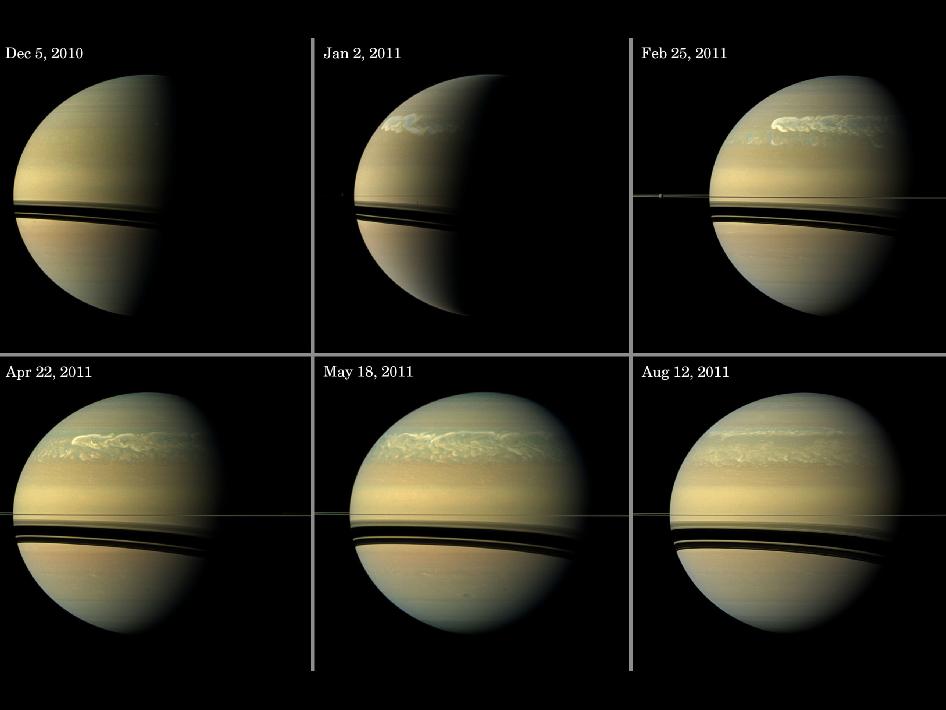
image by NASA/JPL-Caltech/Space Science Institute (source)
That "great white spot" was a bit wider than Earth, and over its record 200-day lifespan has grown into a storm band that encircles Saturn. According to this article, only five other white storms like this have been observed on Saturn in the past 135 years.
~~~~~~~
Today's page is the third of four attempts. The first took hours and hours, following the pencil, ink, wash process I've sort of been building up--it took all that time, I say, and came out badly. This has made me realize that a lot of the more fundamental problems I'm having with these pages come from the pencil stage; I've been working in a thin, hard, mechanical pencil lead, so light it's hard to see, and it can't be used to do shading very effectively to test things out; also, I'm on a relatively thin (70 lb) paper at the moment, and it probably couldn't take really heavy pencil and eraser work--not without risk of damage, anyway. It's also been "buckling" (also called "cockling"--anyway, warping in random waves that form distracting light and dark patterns across the scanned pages) a bit from the ink and wash layers I've been applying, AND unlike the fifteen year old acid-having pad I did my initial tests on, this new acid-free stuff doesn't really show the ink any brighter than the cheap (I now realize) Strathmore Bristol I was using earlier.
So it's time to upgrade my materials again, I think: I want to get one of those cool "lead holder" pencil-like things some of the pros use, so I can really throw graphite around heavily; I think the give and take, fighting it out that I used to do digitally with the lasso tool is going to have to take place at the pencil stage, because ink takes, but doesn't really give. :P So I need to pencil (and erase) heavily to work out a dynamic image, because all the inking in the world won't fix a dull pencil sketch. Gar!
And to do that I also need a sturdy paper, and ideally one that will buckle less from liquids, and show ink more brilliantly. I hear good things about this fancy French "Arches" (pronounced "arsh") paper, and if I get it in bulk packs at the local art supply store and cut the sheets carefully, it'll only cost a bit over $1 per A* page, which really isn't that bad for 140 lb bright white hot press top quality watercolor paper. Hopefully they have some in stock when I storm over there tomorrow. I'm not sure they have the lead holders, so I may just have to order that online; speaking of which, I've also got a couple more paper pads, these by Canson, another French company, on their way from dickblick.com; one is another 70 lb drawing pad, which I now realize probably won't work because it's too light for the washes I want to do, but the other is a 140 lb illustration pad, and it supposedly has a special surface treatment that minimizes bleeding or something and makes it great for pencil and pen and ink. So I'm kind of interested in seeing how that does when it gets here, although it does have an "ultra-smooth" surface that I'm not too sure I'll like.
Anyhoo, so this surviving version of today's page was freehanded without any pencil layout--fortunately it was a pretty simple subject, so it only came out a *little* funky looking. It does have a nice dynamic free ink look that most of my pages have lacked, though, so I need to find a way--hopefully by some of the means described above: heavier paper and pencil and attacking--to marry that with reasonably accurate layouts.
|
·····
|
| |
| Girls in Space, and in radium | Oct 05, 2011 4:32 AM PDT | url |
| | |
Added 1 new A* page:Brush and ink practice--my first real brush and ink painting, in fact:

It's a preliminary version of a prospective guest art (you're probably not really supposed to show these at least until the other comic has them up, but hey then I wouldn't have much to put up today, so oh well hopefully they won't be too mad) for the webcomic Girls in Space, a whimsical, colorful science fiction romp starring a pack of feisty young women...in space. Quite colorful and worth checking out!
My attempt in no way does it justice...in fact it's quite an awful painting really, with terribly crude handling of the brush, backwards technique, and boo-boos everywhere, but believe it or not, it's miles better than my previous brush and ink attempts from a week ago, which were so reprehensible I couldn't show them to you at all. :o
That relative success is due in large part to having upgraded my materials; whereas before I was trying to work with synthetic brushes (da Vinci "Cosmotop Spin") and eh sorta regular ink ("Speedball"), this time I had on my side a da Vinci "Maestro" brush (size 3!) and Japanese "Sumi" ink; the Maestro, made by hand like this in Germany, totally blows away the synthetic brushes in terms of flexibility and precision, and the "Sumi" ink is just way blacker and easier to spread than the other stuff I tried--nice neutral grays when you use it in a dilute ink wash, too.
What also saved my bacon was liberal application of Dr. Ph. Martin's Bleed Proof White, which is essentially the "White Out" of the ink world, I guess. It was also a lot whiter than the old sketch pad paper I'm using for these practice attempts, so actually it maked for a pretty good all-around highlight, in addition to erasing some of my more glaring boo-boos. ... I'm gonna need to get a bunch more bottles of this stuff. It's fun to do stars with it, for instance!
~~~~~~~
Well yet again I accidentally stumbled across a bunch of neat science stuff today; still wanna get another ink practice piece in tonight so let's see how fast I can run these down:
- Seven supernovas exploded in the last 60 years (say that five times fast!) in galaxy Arp 220, in which two galaxies are actually colliding; this somewhat violent coming-together touches off a lot of starbirth--and death--activity as material from both galaxies comes together to form sudden high-density regions. All this activity has made it the nearest (at 250 million light years away) "ultraluminous infrared galaxy"--most of the energy reaching us is in the form of infrared light. Anyway, seven near-simultaneous supernovae in a galaxy is apparently a new record; it is estimated that a supernova occurs about every 25 years in Arp 220, whereas in the Milky Way for instance we only get one about every 100 years.
- I've posted a bunch before about Saturn's cool moon Enceladus and its ice geysers. The Cassini probe has continued to study these amazing phenomena, and found that not only do the ice crystals they emit rain down on Saturn, but they also coat Enceladus in a thick layer of snow--up to 300 feet deep in spots! I guess maybe that's what we can see in this cropped-to-fit-the-news-page version of one of those Enceladus images I posted before:
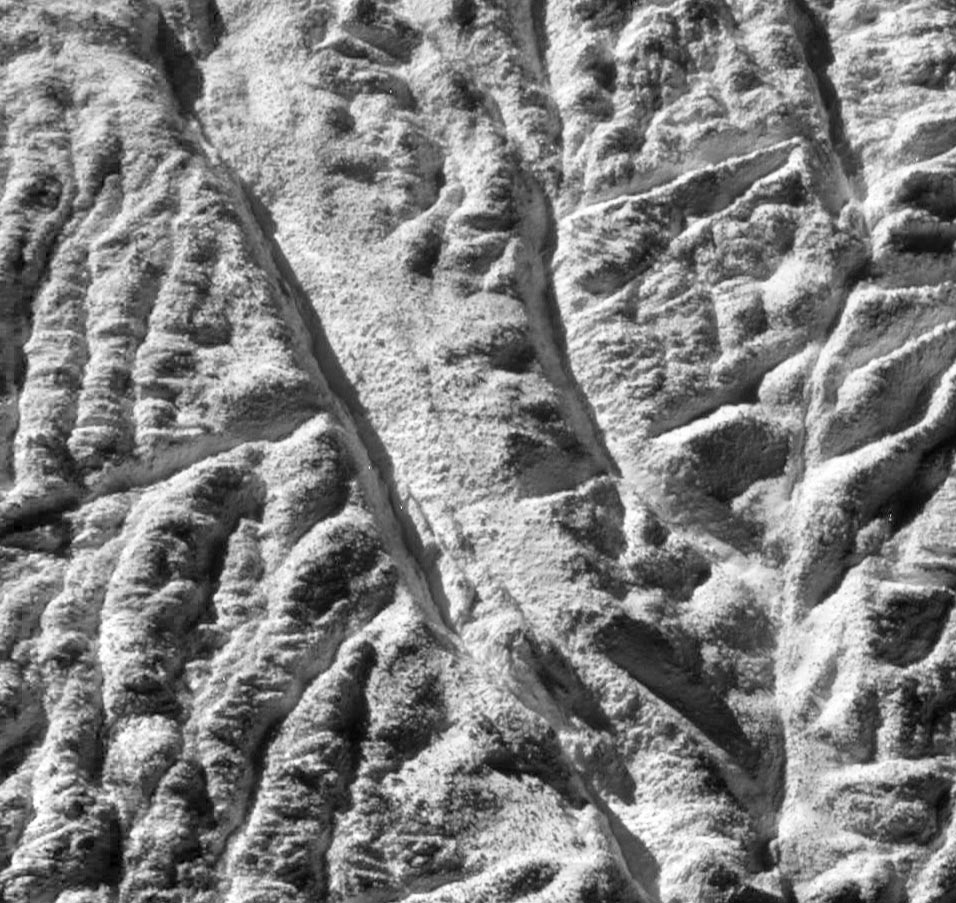
image by NASA (source)
- The Atacama Large Millimeter Array, an international radio telescope installation being built in the high Chilean desert, has just begun to come online; although only about a third of its planned 66 7-and-12-inch radio telescopes are up and running now, it's already a world-class radio telescope by current standards. Radio telescopes read wavelengths that are much longer than those read even by infrared telescopes, so not only can they see really really old light from near the beginning of the universe--this light having been stretched to radio wavelengths by the subsequent expansion of the universe--they can also see right through fields of thick gas and dust that might block the vision of other telescopes; longer wavelengths are less likely to be blocked by such impediments because their "waves" vibrate back and forth less frequently on their journey, and are thus less likely to strike an obstacle like a gas molecular or dust particle (this is also why sunsets are red: the shortest, liveliest visible wavelengths are blue, so blue light from the Sun gets blocked more by the atmosphere--hits more stuff in the air--than red light from the Sun, so the Sun appears reddish when seen through a lot of atmosphere as it nears the horizon).
The array of linked radio telescopes, which will use computer coordination to work together to as one (or multiple, I guess, if they split up for separate tasks) massive telescope, will eventually cover a 16-km swath of the high desert! Here's a view of nineteen of the telescopes in place:
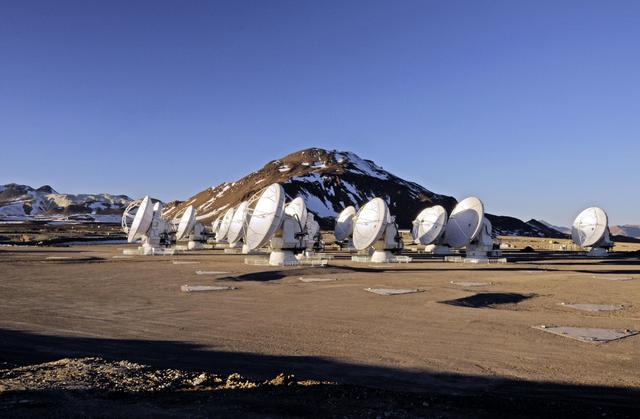
image by ALMA (ESO/NAOJ/NRAO)/W. Garnier (ALMA) (source)
When complete ("by 2013"), it will be far and away the most powerful radio telescope on Earth, with a "spatial resolution of 10 milliarcseconds, 10 times better than the Very Large Array (VLA) and 5 times better than the Hubble Space Telescope." Radio telescope images tend to be kind of blobby rather than sharp and precise like visible light telescope images, but still, they can be very useful, and can be composited with light from visible and other wavelengths to reveal large-scale structures not otherwise apparent; that last photo of galaxy M84 that I posted yesterday, for instance, showed radio data from the VLA in red, illustrating giant lobes of hot gas shooting out from the supermassive black hole at the galaxy's center.
Speaking of supermassive black holes, the official ALMA press release (which has some typos that I'm trying to avoid) indicates that our galaxy's own supermassive black hole Sgr A* will be the subject of intense study by the giant telescope:
26,000 light years from us in the center of our galaxy, sits Sagittarius A*, a supermassive black hole four million times the mass of our Sun. Gas and dust between it and us hide it from our optical telescopes. However, ALMA is tuned to see through the galactic murk and give us tantalizing views of Sgr A*.
Heino Falcke, an astronomer at Radboud University Nijmegen in the Netherlands, said, “ALMA will let us watch flares of light coming from around this supermassive black hole, and make images of the gas clouds caught by its immense pull. This will let us study this monster’s messy feeding habits. We think that some of the gas may be escaping its grip, at close to the speed of light.” |
Go ALMA!
EDIT: I should mention that you can see the initial releases of ALMA radio images--of star-forming regions in the Antennae galaxies, superimposed on Hubble visible data--in that same press release. Here's one of the sharper ones, for instance.
- And then there's radium! I was looking up the element radium for a reason that I may tell you about later (>_>), and there's some interesting stuff in the history of its discovery and use! Radium is over a million times more radioactive than the element from whose decay it is obtained--uranium--and its hazardous nature was realized pretty early on; for instance, in 1900, two years after its discovery (by the Curies), famed French physicist (oops, there's another tongue-twister) Antoine Becquerel got an ulcer on the skin next to his waistcoat pocket after carrying a small ampule of radium in it for six hours. Yes Antoine, maybe you shouldn't do that! Radium takes most of the blame for Marie Curie's eventual death, too--she also observed getting an ulcer from it after carrying a sample around all day.
Still that didn't keep early industry from using radium in all kinds of things. Right up into the 60's in fact it was used for glow-in-the-dark watch dials; and in the 20's a lawsuit was filed on behalf of the Radium Girls--a group of watch painters working for the U.S. Radium Corporation, whose daily task was painting those little glowing dots on watch dials with radium paint

image from Revised Work Plan, Volume 1 of 2, U.S. Radium Site, City of Orange, Essex County, New Jersey (source)
They were encouraged to keep their paint brushes nice and sharp (I'm using The Masters Brush Cleaner and Preserver for a similar purpose!) with their lips and tongues, and had fun by using the radium paint on their own faces to make glow-in-the-dark masks. :o This of course led to very bad medical complications such as radium jaw and, in some cases, death, although the exact number of deaths caused to the Girls isn't known; defending lawyers for the corporation blamed the Girls' illnesses on syphilis, implying thereby of course that they were scandalously loose women.
Radium is particularly nasty when it gets in the human body, because our body treats it like calcium (a lighter element in the same column of the periodic table), sending it to right to our bones, where its radiation can degrade bone marrow and mutate the cells. (And horrifyingly, early on it was used "in products such as toothpaste, hair creams, and even food items due to its supposed curative powers"!)
Fortunately, justice somewhat prevailed, and the five Girls who had filed the suit eventually won "$10,000 (the equivalent of $128,000 in 2010 dollars) and a $600 per year annuity while they lived, and all medical and legal expenses incurred." The case was also remarkable in that it was widely covered by the media; it led to a much greater public awareness of the dangers of radioactive materials, and "the right of individual workers to sue for damages from corporations due to labor abuse was established as a result of the Radium Girls case."
- Radium was also a key tool in the famed Rutherford experiment that led to the discovery of the atomic nucleus! In this 1909 experiment at the University of Manchester, alpha particles (consisting of two protons and two neutrons, just like a helium nucleus) radiated by radium were aimed at a thin gold foil surrounded by a circular sheet of zinc sulfide, which lights up when struck by an alpha particle; the idea was to measure the deflection of the radiation after it hit the gold foil.
According to the prevailing "plum pudding" atomic theory of the day, the radiation should have more or less gone straight through the foil, whose gold atoms were thought to consist of negatively charged electrons floating in a sea of positive charge. But quite to the contrary, the detection sheet showed that while most of the radiation went through, some of it deflected off at wide angles, even close to 180 degrees--right back at the radium source! Rutherford said of it
| It was quite the most incredible event that has ever happened to me in my life. It was almost as incredible as if you fired a 15-inch shell at a piece of tissue paper and it came back and hit you. On consideration, I realized that this scattering backward must be the result of a single collision, and when I made calculations I saw that it was impossible to get anything of that order of magnitude unless you took a system in which the greater part of the mass of the atom was concentrated in a minute nucleus. It was then that I had the idea of an atom with a minute massive center, carrying a charge. |
~~~~~~
Man, that took a while. I've got to stop reading the internet!
|
·····
|
| |
| First LEGO woman and men launch for Jupiter | Aug 06, 2011 2:08 AM PDT | url |
| | |
Added 1 new A* page:Keep an eye out for a new page of my weekend fairy tale comic, "The Princess and the Giant," this coming Sunday; here's a preview of / link to last week's page:

~~~~~~
With all the talk I've been doing of solar activity and flares and so forth in recent weeks, wouldn't you know it that the effects of some strong recent flares are arriving on Earth starting today, where they "could affect some communications for a day or so." So watch out! But these aren't particularly powerful ones; the article quotes the director of the NOAA's Space Weather Prediction Center in Boulder, Colorado as saying that the current solar storm "on a scale of 1 to 5 ... is probably a 2 or 3." For comparison, the article mentions--though not by name--the "Solar Superstorm" of 1859, the strongest solar storm on record, which even managed to burn down a telegraph office or two; I talked a bit about that 1859 event recently, right here.
~~~~~~~~
I mentioned earlier in the week that NASA's Juno spacecraft would be launching for Jupiter today (Friday the 5th), and indeed it went up right on cue on its wasp-waisted Atlas V rocket:
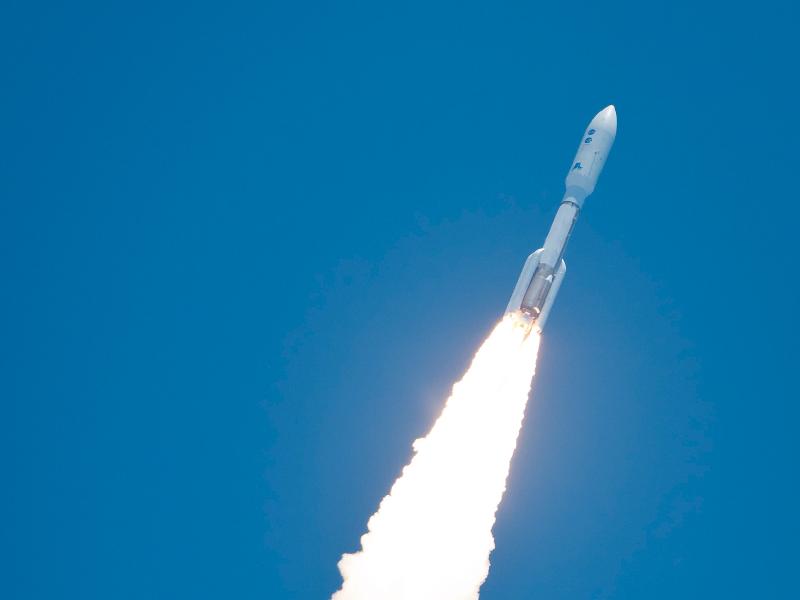
image by NASA/Bill Ingalls (source--#5 in that gallery, since I can't link to it directly)
With advances in solar panel technology, they were able to make Juno solar powered, even for operation around Jupiter, which at about 800 million kilometers out is five times as far from the Sun as Earth is, and the sunlight reaching it--or the solar panels of a spacecraft orbiting it--proportionately weaker. All the previous spacecraft to visit Jupiter--"Pioneer 10, Pioneer 11, the Voyager program, Cassini–Huygens, and the Galileo orbiter"--obtained their power from the decay of radioactive elements, in what is called a radioisotope thermoelectric generator. But scientific progress has allowed Juno to "go green," so it will be all solar rather than nuclear.
That AFP article I linked about the launch mentioned a few interesting details that I thought I'd highlight. It points out that Jupiter "has more than twice the mass of all planets in the solar system combined and is believed to be the first planet that took shape around the Sun." Also, Juno is due to reach Jupiter in 2016, and it was launched at a pretty high speed, but some creative maneuvering will help get it up to a higher speed for catching Jupiter; due--I guess?--to how the orbits of the planets work out, it will first go to the Sun, then will come *back to Earth* in a couple years before heading out toward Jupiter: "Juno will spend the first two years of its mission going around the Sun, then will return for a flyby of Earth which will give a gravitational boost to accelerate Juno on a three-year path toward Jupiter."
So see you in a couple years, Juno!
And rather amusingly--and commercially, I suppose, although the reason given is "to inspire children to explore science, technology, engineering and mathematics" (if they gave these out for free at schools that might work better!)--Juno has three tiny passengers on-board: custom LEGO-like figures sculpted in the forms of Galileo (discoverer of four of the planet's moons), the Roman god Jupiter, and Jupiter's wife, Juno; I'll let you sort out which is which in this photo, or you could cheat by reading NASA's article about them:
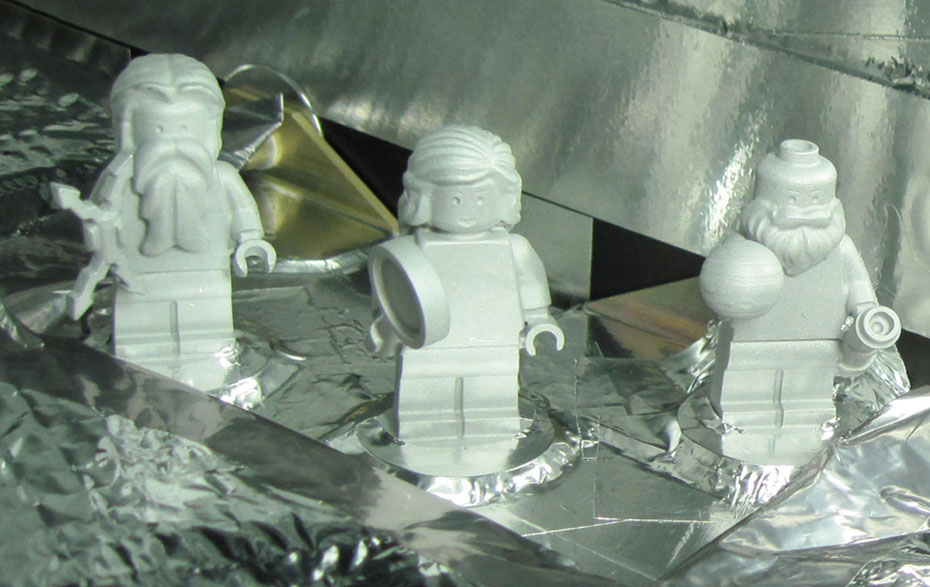
image by NASA (source)
(That's supposed to be a magnifying glass the middle one is holding, by the way! Kind of a big one... At first glance I thought it was a frying pan, and was all like "Oh NO they di-in't!")
|
·····
|
| |
| Icy ions and hungry supermassive black holes | Jun 21, 2011 1:49 AM PDT | url |
| | |
Added 1 new A* page:"A* is a black and white, panel by panel look into the future. I'll take a room at the Metropole Station."
-- Dugan's Air Force |
An April BBC article (yes I'm kind of behind in my news queue...need to close some of these tabs I've been keeping open! :P) says that auroral activity on Saturn has been linked to the planet's small moon Enceladus, and specifically to the salty ice particles Enceladus' geysers shoot out into space--ions in this material end up forming an electrical circuit with Saturn, connecting at Saturn's poles, where they cause the visual effect of an aurora.
I posted about aurorae on Jupiter and Saturn on the A* forum before (Jupiter's aurorae have been attributed to three of its moons), including this nice old Hubble ultraviolet photo of Saturn's polar lights:
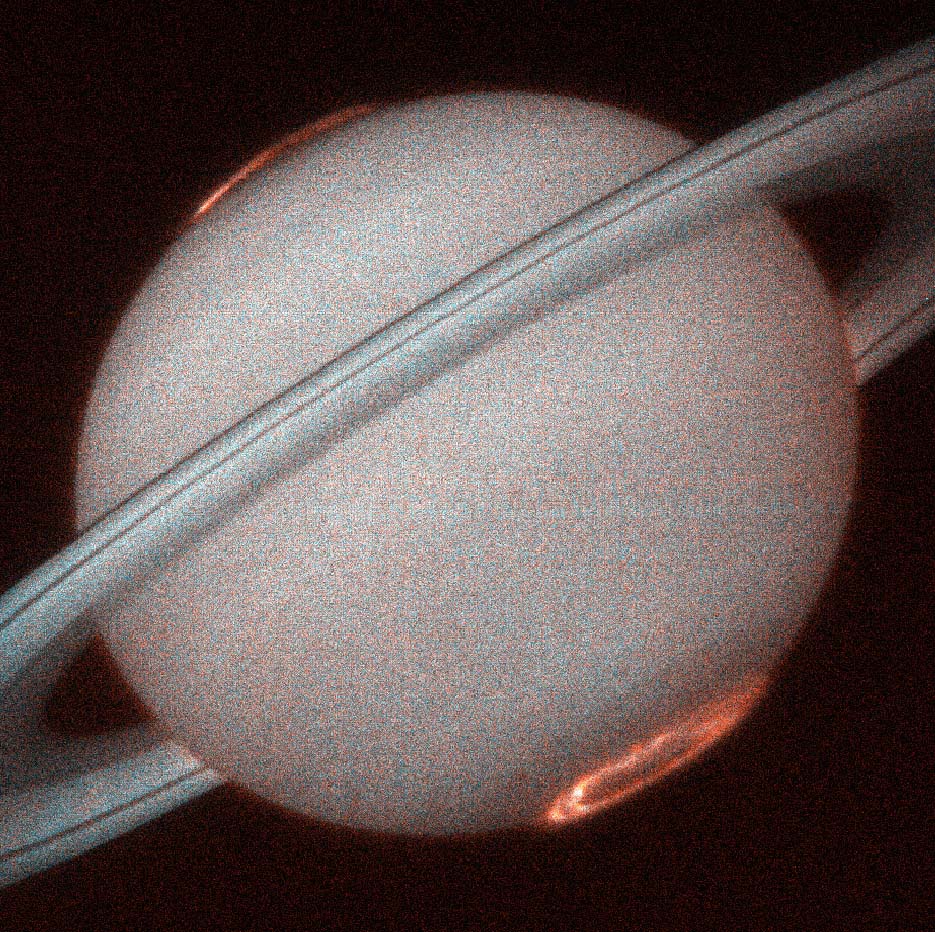
image by NASA (source)
I've also posted on the A* forum about Enceladus before, so handily enough I already have a few photos illustrating its icy activity; for instance, here's the 500 km moon going through the ice crystals it has left in the path of its own orbit
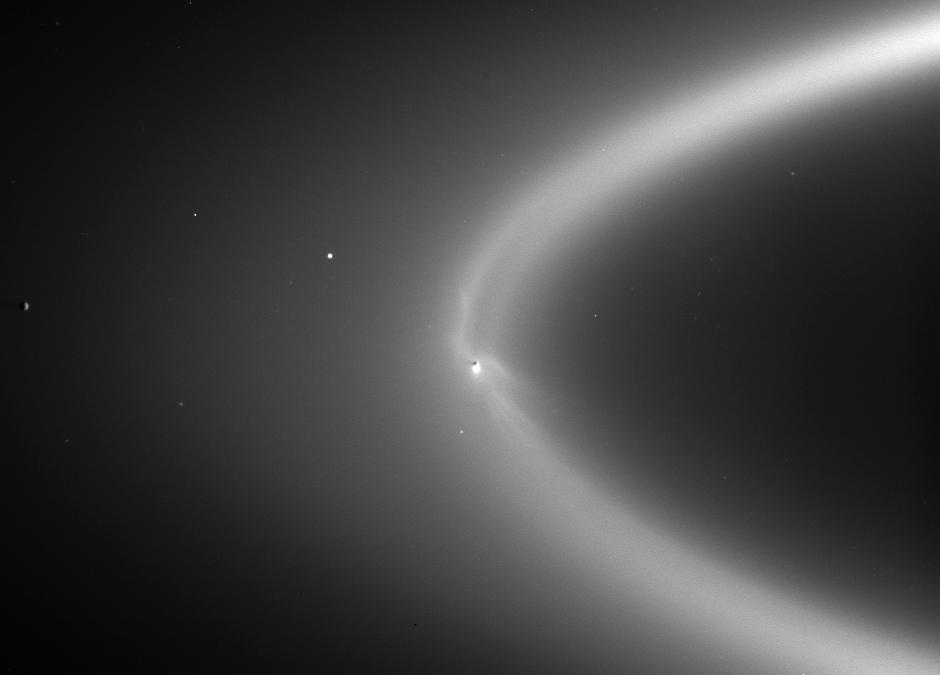
image by NASA (source)
and then we have a nice dramatic wide shot of some of its ice geyser activity:
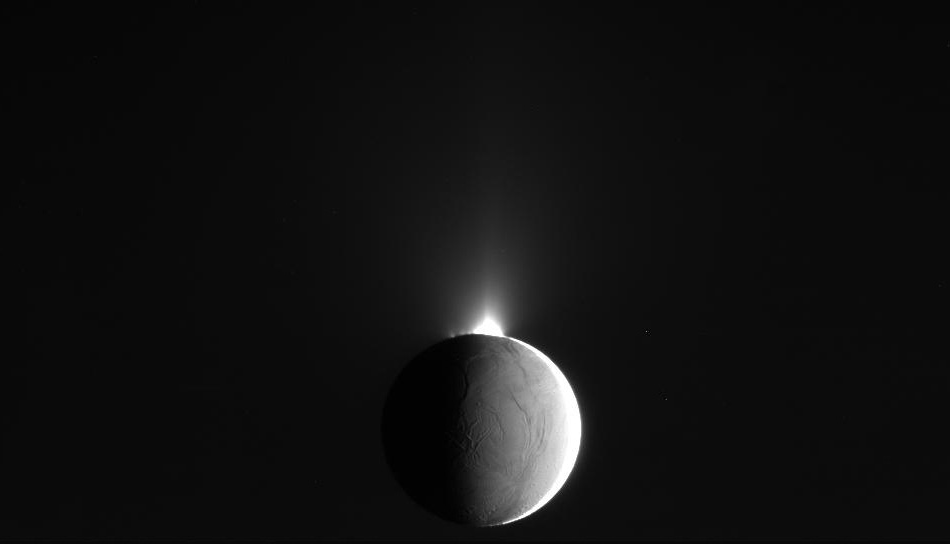
image by NASA (source)
~~~~~~~
And staying in the theme of following up on stuff I've written a bit about before, you may recall that back at the end of May I wrote about an unusually large, unusually powerful gamma ray burst picked up by the Swift satellite:
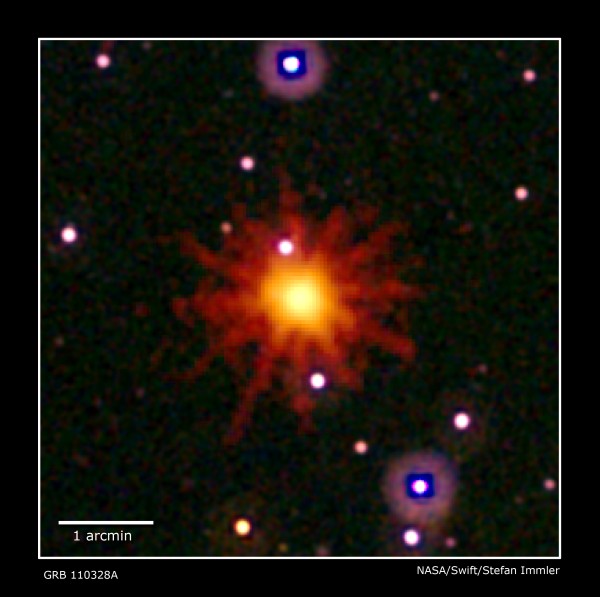
image by NASA (source)
The thinking at the time was that all that energy probably resulted from a star being pulled into a large black hole, and according to this recent article, that has now been confirmed, and the source galaxy identified as "a small galaxy in the Draco constellation, some 3.8 billion light-years away." So that galaxy's central supermassive black hole sucked in a star; gravitational, electromagnetic, and who knows what other forces tore it apart as it fell into the hole; and the hole's magnetic field channeled much of the resulting energy into beams shooting out from the poles of the supermassive black hole--and we just happened to be in the way of one of them, 3.8 billion years later.
~~~~~~~
And then there was the announcement last week that Iran had launched its second satellite, "Rasad," meaning "observation," into orbit, supposedly to take photos for high-resolution maps of Earth. Their first satellite launch, "Omid," took place in 2009; and last year, they claimed to have "launched a rocket carrying a mouse, turtle, and worms into space."
Good on them, I suppose (less good for the mouse, turtle, and worms; of course you'd think if they do have a good camera up in space they'll have lots of things they'll be using it to peer into in oh say the United States, but hey we do the same to them--and to animals with one-way tickets to space), although when the announcement comes via their state TV, beginning with a phrase like "our glorious scientists," and with no external source being able to confirm such launches, you kind of wonder a bit. But here's hoping they are coming closer to space exploration, and to the international scientific cooperation that almost inevitably goes along with it.
|
·····
|
| |
| Star stuff in our neighborhood | Apr 04, 2011 9:47 PM PDT | url |
| | |
Added 1 new A* page:Looks like my new drawing tablet won't get here until tomorrow :|, so although I finished the script for episode 13, I can't start in on the storyboards yet. According to the script it's going to be a pretty long episode--165 pages or so--so I'd probably need at least three full days to draw that many storyboards, but since I'll now only have two at best before I run out of episode 12 pages (and I still need to finish up the last one, actually :P), this means that I'll probably still have to be drawing storyboards while also starting in on actual episode 13 pages on Thursday, which means (this is the only part that really matters for you the reader) that I probably won't get up to my usual two-pages-per-day speed until some time the following week. Botheration!
So not having a way to draw today, I'm just puttering around doing any non-drawing thing I can think of, like shipping off an art print, proof-reading the script like four more times, uh and I'll probably go dink around with my ads or something later. But I also came up with a pretty fat blog entry topic over the weekend, and so I might as well burn through that today while I can't draw. Here goes then!
Wikipedia's list of nearest stars is pretty neat, and reading through its entries really starts to give an idea of the immense variety of stuff there is out in space, even just around our own quiet little star system! For instance, you may have heard lots of times that the nearest star to us (at just over four light years--could have sworn the figure I was given as a kid was more like 3 ly, but eh I have a bad memory so who knows) is Alpha Centauri--except that Alpha Centauri isn't a star, it's two--and actually maybe even three, since it turns out there's a red dwarf star, Proxima Centauri, that may be gravitationally attached to the two other stars--which are much closer together--making it a triple star system, or "trinary." Just think, the closest star to us, actually a triple! Or at least a double. Makes our single star seem a bit boring by comparison, perhaps.
Of course, we have planets, and they...may not. There's been a lot of controversy of people claiming to have spotted evidence for planets in Alpha Centauri, but for the most part they seem to have been rebuffed for the time being.
But there's more stuff that makes Alpha Centauri pretty interesting. The small Proxima Centauri, just a bit over a tenth of the Sun's mass and diameter, and too faint to be seen with the naked eye, even as close as it is (it's about a tenth of a light year closer than its two larger siblings), sometimes increases in magnitude by up to 8%: it's a very active "flare star," and the flaring activity is thought to be the work of a powerful magnetic field.
Alpha Centauri is headed in our direction, too! Proxima, for instance, is moving toward us at about 21.7 km/s (compare with the Voyager spacecraft's 17 km/s); 26,700 years from now, it is expected to reach its nearest distance to us, 3.11 light years. Alpha Centauri as a whole is projected to vanish from naked-eye view about 100,000 years from now as it moves past us in its orbit around the galaxy.
Here it is--Alpha Centauri A and B, anyway--above the rim of Saturn, as seen by the Cassini spacecraft in 2008:
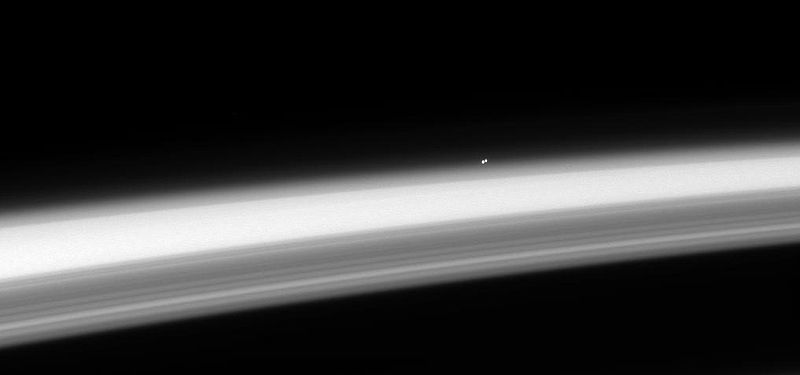
image by NASA (source)
The second closest star system to Earth, at just under six light years away, is Barnard's Star, another red dwarf, just slightly bigger than the teeny Proxima Centauri. Barnard's is the fastest star moving across our night sky
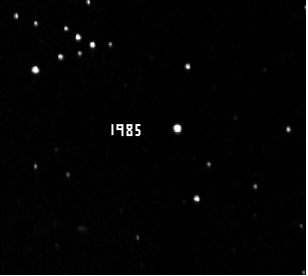
image by Steve Quirk (source)
and it is moving toward us at about 140 km/s--it will reach its closest point of 3.8 light years in the year 11700, but still won't be visible without a telescope. As with Alpha Centauri, lots of people claimed to have discovered evidence of planets around Barnard's Star, and there was even a starship project intended to go there--Project Daedalus in the '70's--with the hope of reaching it and its supposed planets within 50 years, if the ship could hit a theoretical speed of 12% the speed of light through fusion pulse propulsion utilizing intertial confinement fusion of 50,000 tons of deuterium/helium-3 pellets to propel the 4,000 ton craft on a one-way trip; it wouldn't be able to decelerate and stop at Barnard's Star (you'd need ten times the fuel for that, or something, I think... Well I can't remember, maybe I'm just making that up :P), so 18 sub-probes would have launched between 1.8 and 7.2 years before reaching the star, spreading out with nuclear ion drives to observe the star they'd be speeding by. Oh, and getting enough helium-3 to get there would require 20 years of mining the atmosphere of Jupiter via balloon-supported robotic factories, supposedly.
Fun! Not easy to catch a star, much less a fast one, I suppose. Fast as it is relative to us, Barnard's Star is an ancient one; the furthest estimates (the smallest being more like 7) of a 12 billion year age would make it one of the oldest stars in the galaxy! For a star, being old means, among other things, rotating slower: it takes Barnard's Star 130 days to rotate around its axis, vs just 25 for the young punk Sun. Being that old, it also isn't supposed to have much of a magnetic field anymore, but it threw scientists for a loop in 1998, when it suddenly flared to twice its normal temperature. So finding out how that happened would be one big aim of any exploration of it.
Skipping down the list past a couple more red dwarfs, Wolf 359 and Lalande 21185 (although this nice photo of Wolf 359 gives an idea of what a nearby red dwarf might look like through a telescope)
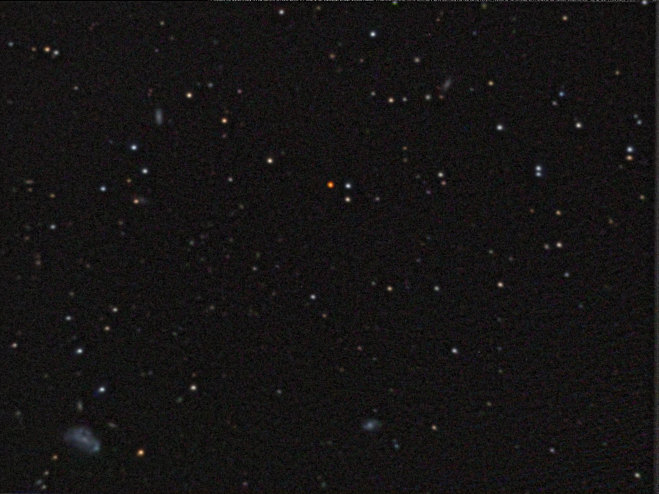
image by Klaus Hohmann (source)
(Wolf 359 is the red dot in the upper middle of the picture) brings us to another binary: Sirius. I've written about it before on the A* forum, so I'll just quote myself here:
There's a white dwarf pretty much right next to us, just 8.6 light years away: Sirius B, and it in fact is one of those dwarfs that's about the mass of the Sun (0.98 solar masses is close!) and the size of the Earth. It's in a binary with Sirius A, which is about two solar masses, and the brightest star in our sky--after the Sun. Here you can see little B and big A; the B dwarf is the little white dot to the lower left of the big A glare:
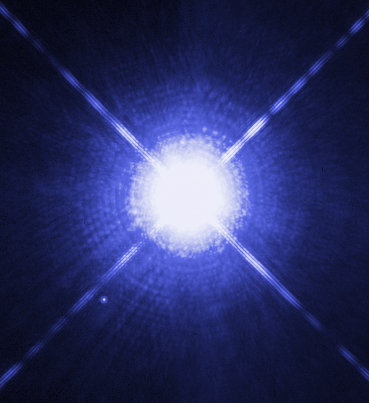
image from NASA (source)
White dwarfs and their "degenerate matter" are pretty awesome, but I'll limit myself to just dropping those links on you for now. :)
Skipping down the list again past four more red dwarf flare stars (the binary Luyten 726-8, then Ross 154 and Ross 248 (Voyager 2 will come within 1.76 light years of Ross 248 in 40,176 years!)), I'll just dwell last on Epsilon Eridani (which will come within a light year of Luyten 726-8 around AD 33500, possibly knocking some comets off or something!), ninth in the distance list at ten and a half light years from Earth.
Epsilon Eridani has extensive disks of debris around it, and has the firmest candidates for an extrasolar planet or two close to Earth, although they're still debated and theoretical, respectively. Epsilon Eridani is all the more exciting to those who like to try to discover planets because it's a "sunlike" star, which is to say that it's not radically different than the Sun in terms of mass, size, and brightness: 82%, 74%, and 34%, respectively. But its magnetic field is stronger than the Sun's, and that's one indicator that has scientists thinking its a relatively young star: maybe between 0.5 and 1 billion years old, for instance (the Sun is about 4.5 billion years old).
While the presence of planets around Epsilon Eridani is hotly debated, the presence of an outer dust disk around it can be pretty firmly proven based on strong infrared readings from the system, and what we can project from that is pretty interesting in its own right. The dust disk seems to have about one-sixth of the mass of the Moon in it, and maybe 5 to 9 Earth masses worth of comets; it is also thought that it would have taken collisions between about eleven Earth masses-worth of "parent bodies" to generate all that stuff. Furthermore, a 2008 study of data from the Spitzer Space Telescope (which sees in the infrared) determined that there are two asteroid belts inside the cometary disk, and that two-belts-plus-disk structure suggests the presence of "more than two planets" to be herding that material into its current configuration.
All that within just ten and a half light years from Earth! (And this isn't counting any Earth or smaller planets that might be there since we can't really spot those with current technology.) And the galaxy is 10,000 times wider than that! And there are maybe more than 170 billion galaxies within just the part of the universe we can see!
... That's gonna be a lot of blog entries. :o
|
·····
|
| |
| Episode 8 planning, pictures, secretzzzz | Feb 23, 2010 7:32 AM PST | url |
| | |
I got most of episode 8's script written today, so tomorrow will be polishing it up and then starting in on storyboards. This episode will take place around nifty stuff like planetary magnetospheres and radiation belts, and hey I put together bunch of nifty magnetosphere reference images for us on the forum, like with aurorae and stuff. (Although the planet in the episode will be too weird to have an aurora, actually. :o) For instance, here's a nifty Cassini image of microwave emission from Jupiter's radiation belts:
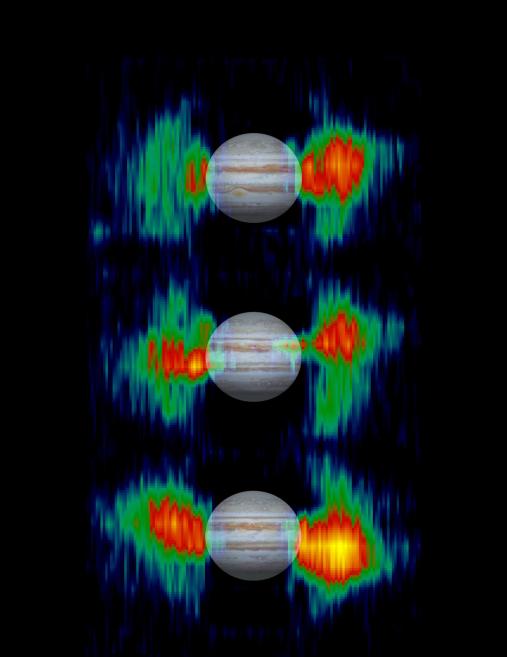
image by NASA (source)
And do you know what the densest natural element is (it isn't lead, gold or uranium!), or the deepest hole ever drilled by humans? Those and other interesting and possibly relevant trivia are to be found behind that link as well!
And I don't have reference photos handy for these, but the episode will also include heaping helpings of deception, double-cross, death, and despair, a sizable smidgen of spite, and at least one space battle. Ooh and we just may find out some actual info behind that deadly encounter at Tempus 477! Oooh (2) and here's a possibly too revealing/obvious hint: how do you hide a star?
If I can draw all this stuff right, episode 8 could turn out pretty good!
|
·····
|
| |
| Episode 5 script done | Jun 22, 2009 11:19 PM PDT | url |
| | |
Here we go starting in on episode 5 already!
The question now is, what's Vero doing out in that asteroid belt around Gabbot's Claim? Oh yeah, and wasn't Solvan Mar, head of Core Sys Corp, trying to have people track him down and kill him?
Finished the script for the episode today. The best line I managed for this episode might be "Now let's cut you open and see what's inside." Wait, my crude side also kind of liked "Get lost before I give you a gigawatt the hard way."
Can you tell that episode 5 is going to have a lot of action? In fact I'm getting a little worried about drawing all of it now that I think of it, but hey, one frame at a time, right? ;D But first, the storyboards, which I'll start tomorrow.
Did no drawing today, so I'll leave you (courtesy of Wikipedia, NASA, and the Cassini orbiter) with one of the prettier pictures I turned up while researching planetary ring systems today; this is the Saturnian moon Enceladus, the sixth-largest moon of the sixth planet in our solar system, whose cryovolcanic activity spews ice crystals into space through four large vents in its south polar region, forming the ring in which it travels around the gas giant:
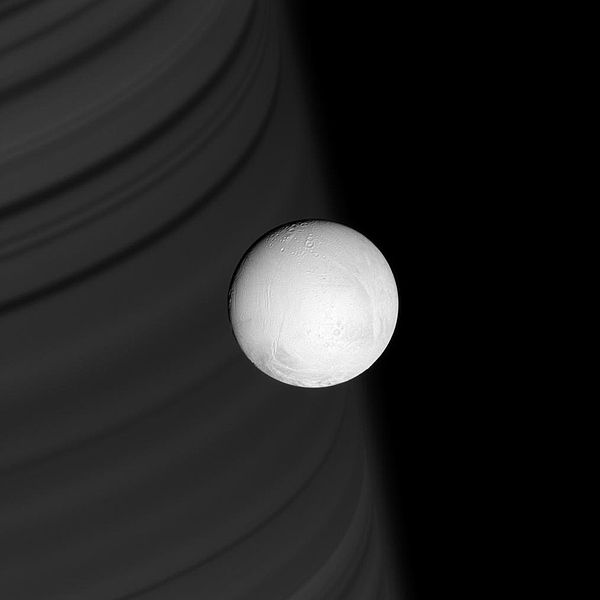
|
·····
|
|
|
